
February 2021
Grade 2: New Jersey Student Learning Standards for Mathematics - Prerequisite Standards and Learning Objectives by Domain
Description
Included here are the prerequisite concepts and skills necessary for students to learn grade level content based on the New Jersey Student
Learning Standards in mathematics. This tool is intended to support educators in the identification of any gaps in conceptual understanding or
skill that might exist in a student’s understanding of mathematics standards. The organization of this document mirrors that of the New Jersey
Student Learning Standards for mathematics, includes all grade- or course-level standards and the associated student learning objectives, and
reflects a grouping of the standards by domain.
The tables are divided into three columns. The first column contains the grade level standard and student learning objectives, which reflect the
corresponding concepts and skills in that standard. The second column contains standards from prior grades and the corresponding learning
objectives, which reflect prerequisite concepts and skills essential for student attainment of the grade level standard as listed on the left. Given
that a single standard may reflect multiple concepts and skills, all learning objectives for a prior grade standard may not be listed. Only those
prior grade learning objectives that reflect prerequisite concepts and skills important for attainment of the associated grade level standard is listed.
The third column contains the recommendations from Student Achievement Partners’ recommendations (SAP) for the 2020-21 school year
regarding preserving or reducing time as compared to a typical academic year.
Content Emphases Key: : Major Cluster : Supporting Cluster : Additional Cluster
Note: Double asterisks (**) indicate that the example(s) included within the New Jersey Student Learning Standard may be especially
informative when considering the Student Learning Objective.
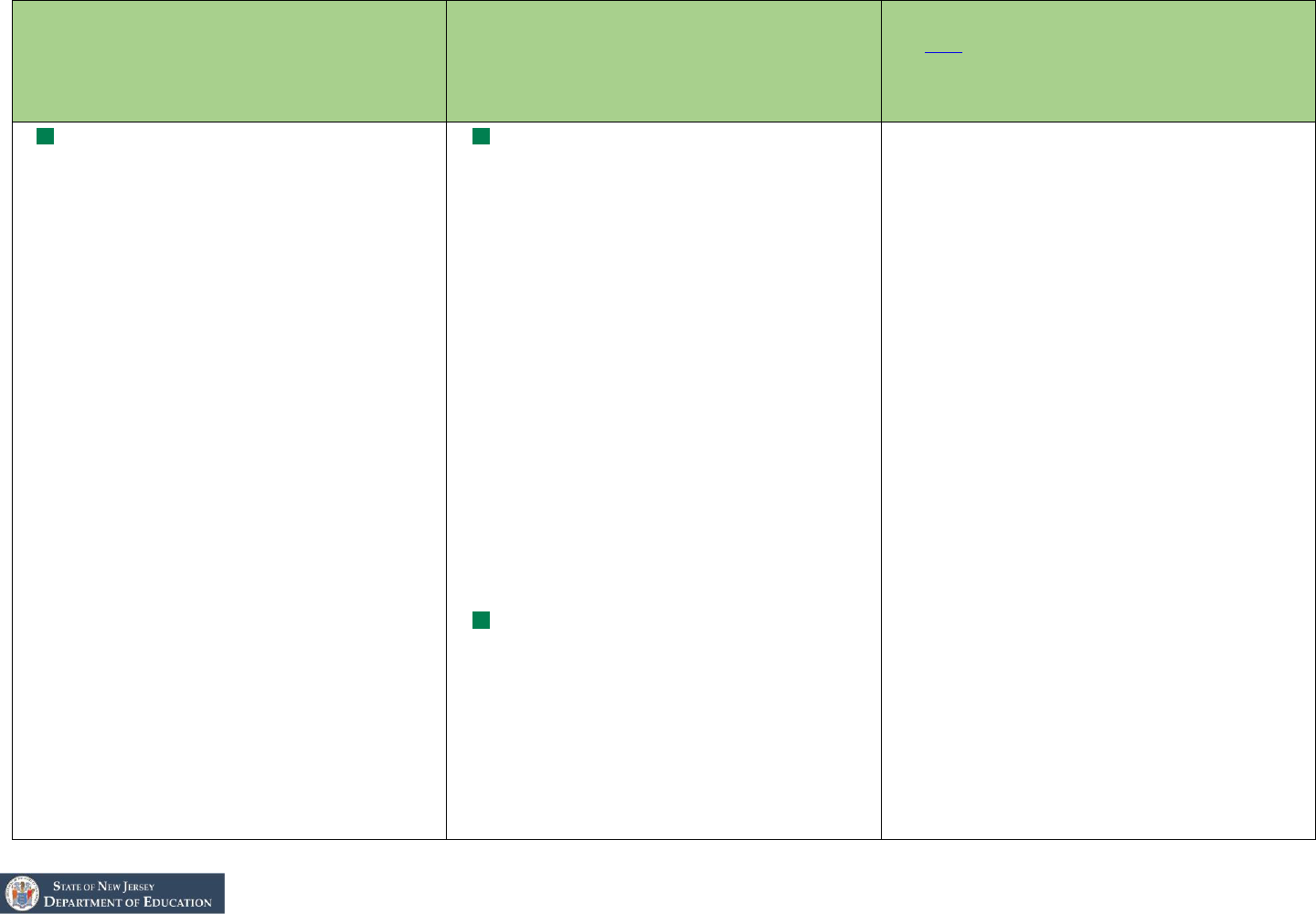
Grade 2: New Jersey Student Learning Standards for Mathematics - Prerequisite Standards and Learning Objectives
2
Updated February 2021
Domain: Operations and Algebraic Thinking
Standard and Student Learning
Objectives
Previous Grade(s) Standards and Student
Learning Objectives
Instructional Considerations
SAP recommendation to preserve or
reduce time in 20-21 as compared to a
typical year
2.OA.A.1 Use addition and subtraction
within 100 to solve one- and two-step word
problems involving situations of adding to,
taking from, putting together, taking apart,
and comparing, with unknowns in all
positions, e.g., by using drawings and
equations with a symbol for the unknown
number to represent the problem.
We are learning to/that…
▪ represent a word problem with drawings
and equations using a symbol for the
unknown
▪ solve one and two-step addition and
subtraction word problems within 100
involving situations of adding to, taking
from, putting together, taking apart, and
comparing
1.OA.A.1 Use addition and subtraction
within 20 to solve word problems involving
situations of adding to, taking from, putting
together, taking apart, and comparing, with
unknowns in all positions, e.g., by using
objects, drawings, and equations with a
symbol for the unknown number to represent
the problem.
We have learned to/that…
▪ represent a word problem using objects,
drawings, or equations using a symbol
for the unknown
▪ solve addition and subtraction word
problems within 20 involving situations
of adding to, taking from, putting
together, taking apart, and comparing,
with unknowns in all positions
1.NBT.C.4 Add within 100, including
adding a two-digit number and a one-digit
number, and adding a two-digit number and
a multiple of 10, using concrete models (e.g.,
base ten blocks) or drawings and strategies
based on place value, properties of
operations, and/or the relationship between
addition and subtraction; relate the strategy
to a written method and explain the
Emphasize problems that involve sums less
than or equal to 20 and/or the related
differences in order to keep the focus on
making sense of different problem types.
Assign fewer problems with sums greater
than 20 or related differences.
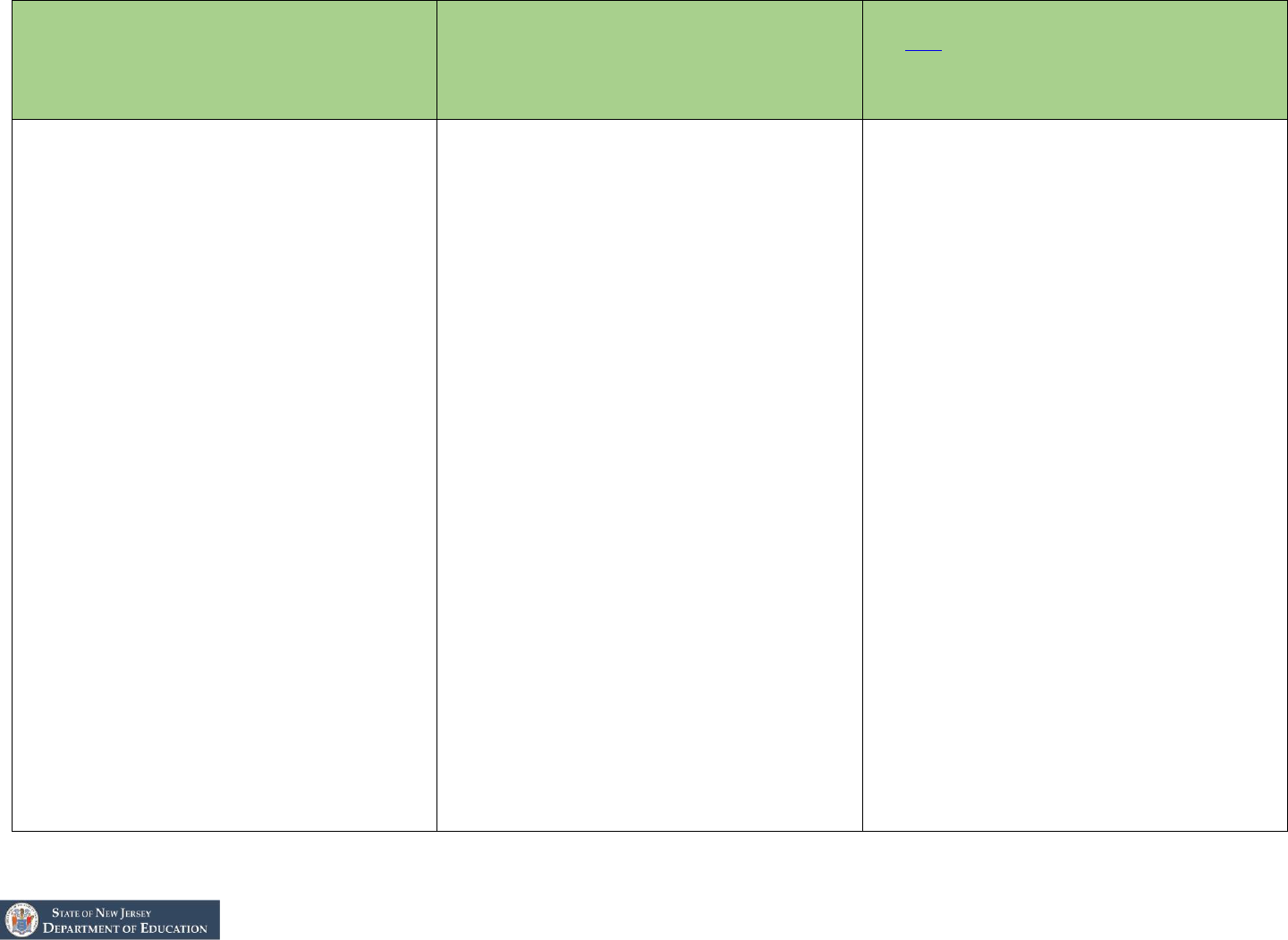
Grade 2: New Jersey Student Learning Standards for Mathematics - Prerequisite Standards and Learning Objectives
3
Updated February 2021
Standard and Student Learning
Objectives
Previous Grade(s) Standards and Student
Learning Objectives
Instructional Considerations
SAP recommendation to preserve or
reduce time in 20-21 as compared to a
typical year
reasoning used. Understand that in adding
two-digit numbers, one adds tens and tens,
ones and ones; and sometimes it is necessary
to compose a ten.
We have learned to/that…
▪ compose tens when adding two-digit
numbers, if necessary
▪ when adding two-digit numbers, one
adds tens and tens, ones and ones
▪ add a two-digit number and a one-digit
number within 100 using concrete
models (e.g., base ten blocks) or
drawings
▪ add a two-digit number and a one-digit
number within 100 using strategies based
on place value, properties of operations,
and/or the relationship between addition
and subtraction
▪ add a two-digit number and a multiple of
10, within 100, using concrete models
(e.g., base ten blocks) or drawings
▪ add a two-digit number and a multiple of
10, within 100, using strategies based on
place value, properties of operations,
and/or the relationship between addition
and subtraction
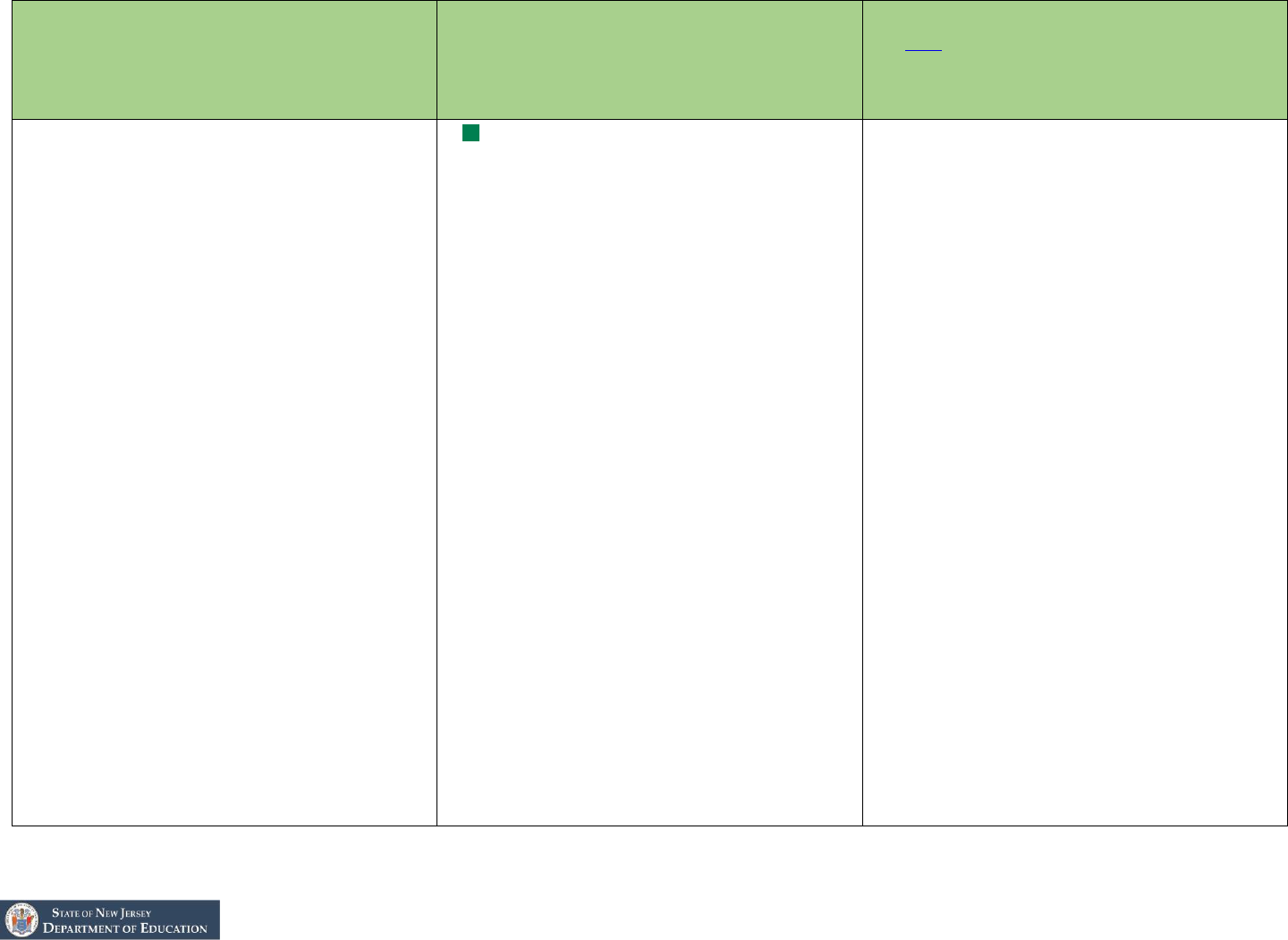
Grade 2: New Jersey Student Learning Standards for Mathematics - Prerequisite Standards and Learning Objectives
4
Updated February 2021
Standard and Student Learning
Objectives
Previous Grade(s) Standards and Student
Learning Objectives
Instructional Considerations
SAP recommendation to preserve or
reduce time in 20-21 as compared to a
typical year
1.NBT.C.6 Subtract multiples of 10 in the
range 10–90 from multiples of 10 in the
range 10–90 (positive or zero differences),
using concrete models or drawings and
strategies based on place value, properties of
operations, and/or the relationship between
addition and subtraction; relate the strategy
to a written method and explain the
reasoning used.
We have learned to/that…
▪ subtract multiples of 10 from multiples
of 10 using concrete models or drawings
(multiples of 10 less than or equal to 90)
▪ subtract multiples of 10 from multiples
of 10 using strategies based on place
value or properties of operations
(multiples of 10 less than or equal to 90)
▪ explain the reasoning used when
subtracting multiples of 10 from
multiples of 10 (multiples of 10 less than
or equal to 90)
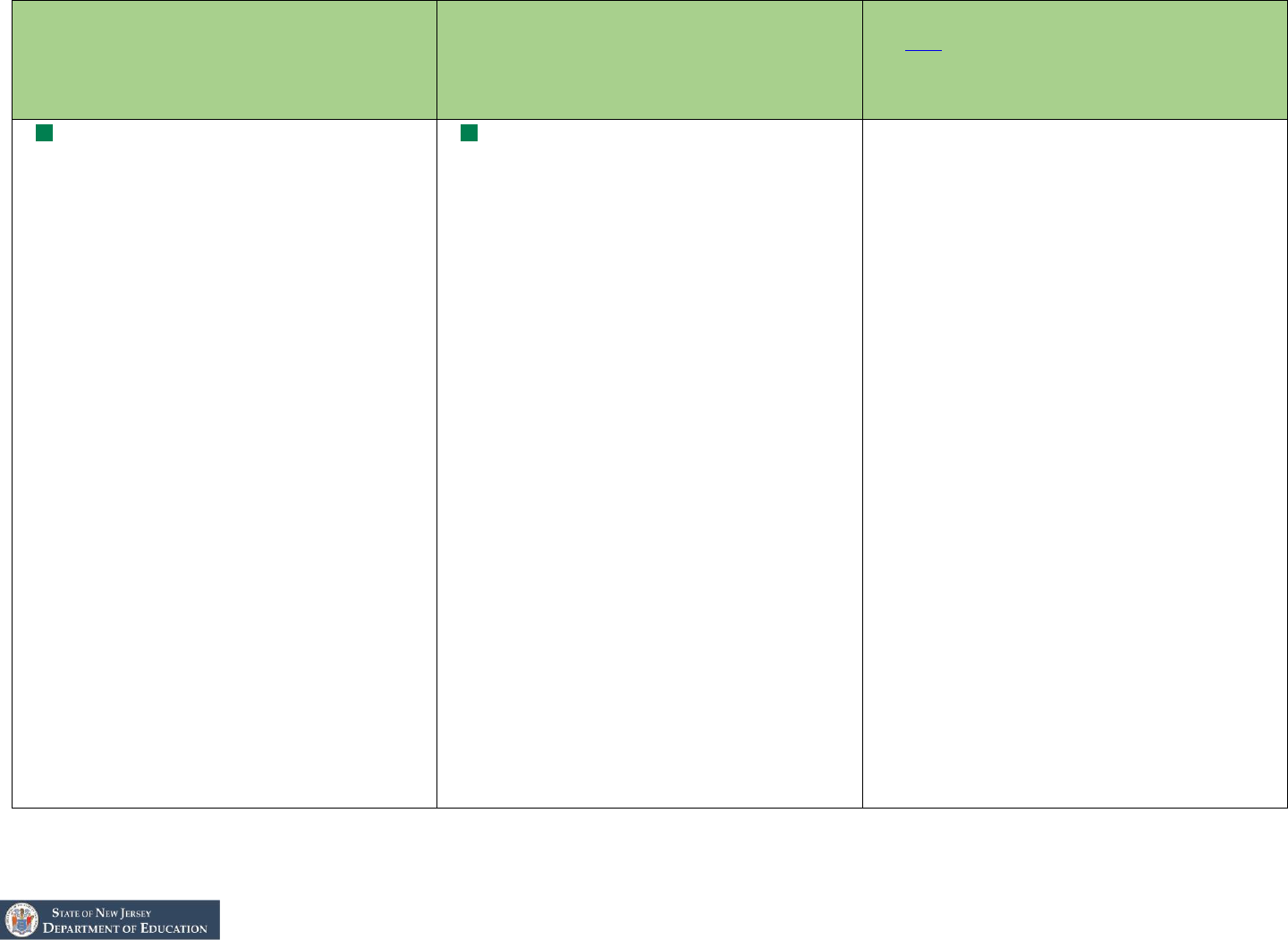
Grade 2: New Jersey Student Learning Standards for Mathematics - Prerequisite Standards and Learning Objectives
5
Updated February 2021
Standard and Student Learning
Objectives
Previous Grade(s) Standards and Student
Learning Objectives
Instructional Considerations
SAP recommendation to preserve or
reduce time in 20-21 as compared to a
typical year
2.OA.B.2 Fluently add and subtract within
20 using mental strategies. By end of Grade
2, know from memory all sums of two one-
digit numbers.
We are learning to/that…
▪ add and subtract within 20 with accuracy
and efficiency
▪ know from memory all sums of two one-
digit numbers
1.OA.C.6 Add and subtract within 20,
demonstrating fluency for addition and
subtraction within 10. Use strategies such as
counting on; making ten (e.g., 8 + 6 = 8 + 2
+ 4 = 10 + 4 = 14); decomposing a number
leading to a ten (e.g., 13 − 4 = 13 − 3 − 1 =
10 − 1 = 9); using the relationship between
addition and subtraction (e.g., knowing that 8
+ 4 = 12, one knows 12 − 8 = 4); and
creating equivalent but easier or known sums
(e.g., adding 6 + 7 by creating the known
equivalent 6 + 6 + 1 = 12 + 1 = 13).
We have learned to/that…
▪ add and subtract within 20 using
strategies such as counting on, making
ten, and decomposing a number leading
to a ten
▪ add and subtract within 20 using
strategies such as relationship between
addition and subtraction, and using easier
or known sums within 10
▪ add and subtract within 10 with accuracy
and efficiency
Incorporate additional practice on the grade
1 fluency of adding and subtracting within
10 (1.OA.C.6) early in the school year to
support the addition and subtraction work of
grade 2 (2.OA).
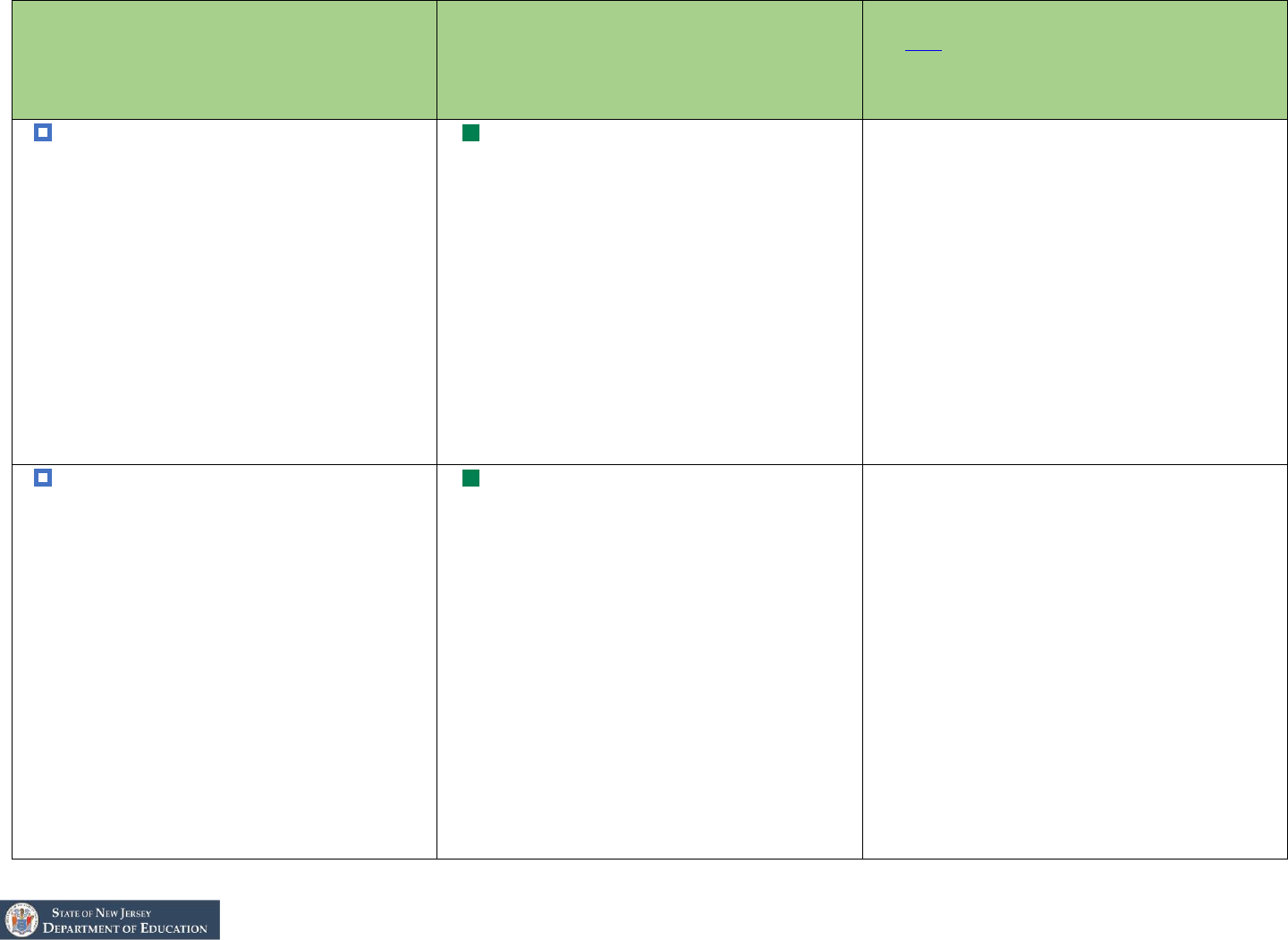
Grade 2: New Jersey Student Learning Standards for Mathematics - Prerequisite Standards and Learning Objectives
6
Updated February 2021
Standard and Student Learning
Objectives
Previous Grade(s) Standards and Student
Learning Objectives
Instructional Considerations
SAP recommendation to preserve or
reduce time in 20-21 as compared to a
typical year
2.OA.C.3 Determine whether a group of
objects (up to 20) has an odd or even number
of members, e.g., by pairing objects or
counting them by 2s; write an equation to
express an even number as a sum of two
equal addends.
We are learning to/that…
▪ determine whether a group of objects up
to 20 is odd or even (e.g., by pairing
objects, counting them by 2s)
▪ write an equation to express an even
number as a sum of two equal addends
1.OA.D.7 Understand the meaning of the
equal sign, and determine if equations
involving addition and subtraction are true or
false. For example, which of the following
equations are true and which are false? 6 = 6,
7 = 8 − 1, 5 + 2 = 2 + 5, 4 + 1 = 5 + 2
We have learned to/that…
▪ determine if equations involving
addition and subtraction within 20 are
true or false using the meaning of the
equal sign
Limit lessons on foundations for
multiplication.
2.OA.C.4 Use addition to find the total
number of objects arranged in rectangular
arrays with up to 5 rows and up to 5
columns; write an equation to express the
total as a sum of equal addends.
We are learning to/that…
▪ use repeated addition to find the total
number of objects arranged in
rectangular arrays with up to 5 rows and
up to 5 columns
▪ write an equation to express the total
number of objects arranged in a
rectangular array as a sum of equal
addends
1.OA.D.7 Understand the meaning of the
equal sign and determine if equations
involving addition and subtraction are true or
false. For example, which of the following
equations are true and which are false? 6 = 6,
7 = 8 − 1, 5 + 2 = 2 + 5, 4 + 1 = 5 + 2
We have learned to/that…
▪ determine if equations involving addition
and subtraction within 20 are true or false
using the meaning of the equal sign
Limit lessons on foundations for
multiplication.
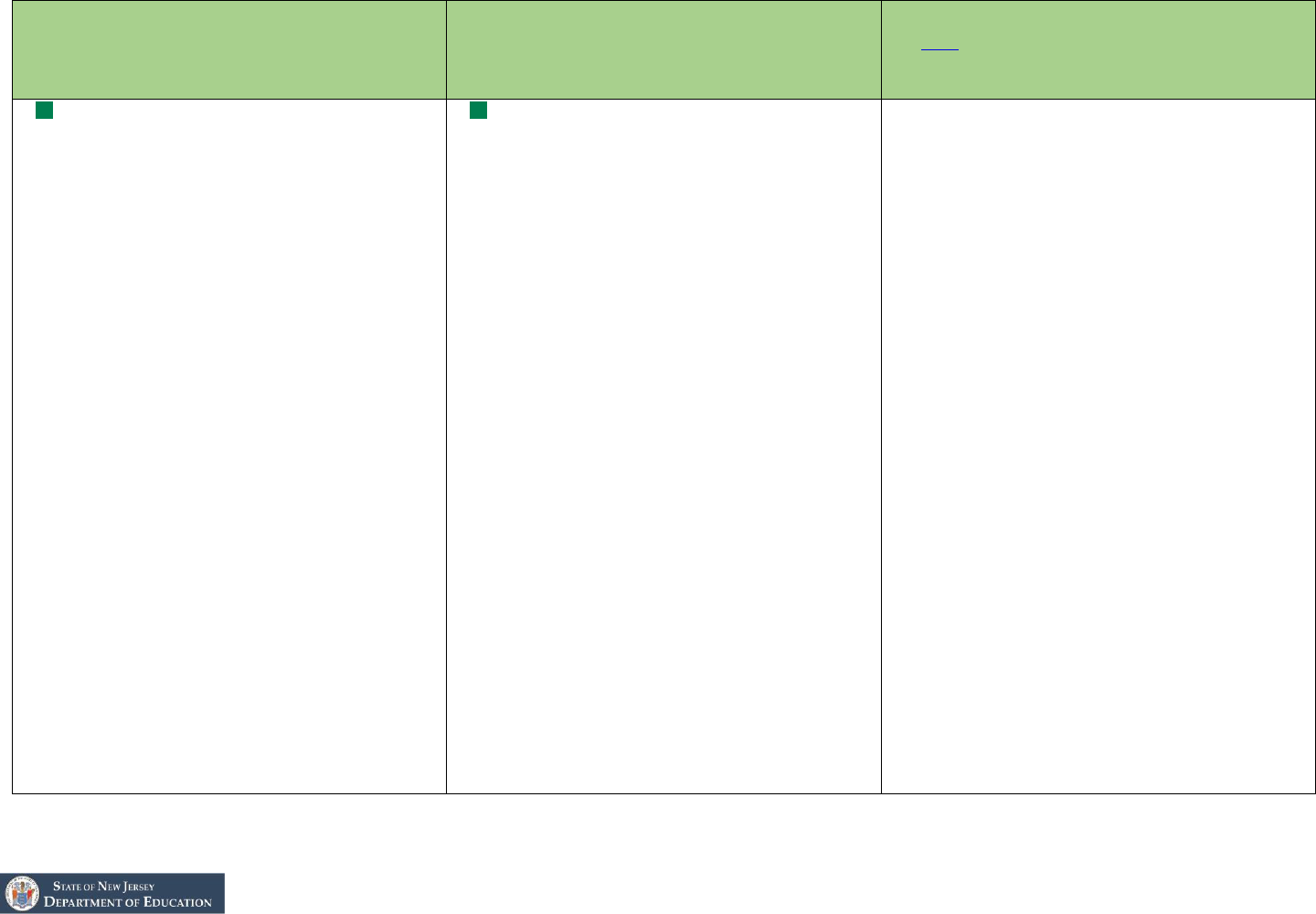
Grade 2: New Jersey Student Learning Standards for Mathematics - Prerequisite Standards and Learning Objectives
7
Updated February 2021
Domain: Number and Operations in Base Ten
Standard and Student Learning
Objectives
Previous Grade(s) Standards and Student
Learning Objectives
Instructional Considerations
SAP recommendation to preserve or reduce
time in 20-21 as compared to a typical year
2.NBT.A.1 Understand that the three
digits of a three-digit number represent
amounts of hundreds, tens, and ones; e.g.,
706 equals 7 hundreds, 0 tens, and 6 ones.
a. 100 can be thought of as a bundle of ten
tens—called a "hundred."
b. The numbers 100, 200, 300, 400, 500,
600, 700, 800, 900 refer to one, two, three,
four, five, six, seven, eight, or nine hundreds
(and 0 tens and 0 ones).
We are learning to/that…
▪ use multiplication and division within
100 to solve word problems in situations
involving: equal groups, arrays and
measurement quantities
▪ use drawings and equations with a
symbol for the unknown number to
represent multiplication and division
word problems within 100
1.NBT.B.2 Understand that the two digits
of a two-digit number represent amounts of
tens and ones. Understand the following as
special cases:
a. 10 can be thought of as a bundle of ten
ones—called a “ten.”
b. The numbers from 11 to 19 are composed
of a ten and one, two, three, four, five, six,
seven, eight, or nine ones.
c. The numbers 10, 20, 30, 40, 50, 60, 70,
80, 90 refer to one, two, three, four, five, six,
seven, eight, or nine tens (and 0 ones).
We have learned to/that…
▪ 10 can be thought of as a bundle of ten
ones called a “ten”
▪ the numbers 11 to 19 are made up of one
ten and one, two, three, four, five, six,
seven, eight, or nine ones
▪ in a two-digit number, one digit
represents the amount of tens and the
other digit represents the amount of ones
▪ the numbers 10, 20, 30, 40, 50, 60, 70,
80, 90 are made up of some tens and 0
ones
Emphasize the conceptual understanding of
three-digit numbers (as detailed in
1.NBT.A.1).
Integrate lessons and practice on counting,
reading/writing, and comparing numbers
(2.NBT.A.2, 2.NBT.A.3, 2.NBT.A.4) into
the work of place value.
Limit the amount of required student practice
on counting by ones, reading/writing and
comparing numbers.
Note: While the standards in cluster
2.NBT.A are Major Work of the Grade,
during the 2020-21 school year, it is
recommended that they receive lighter
treatment
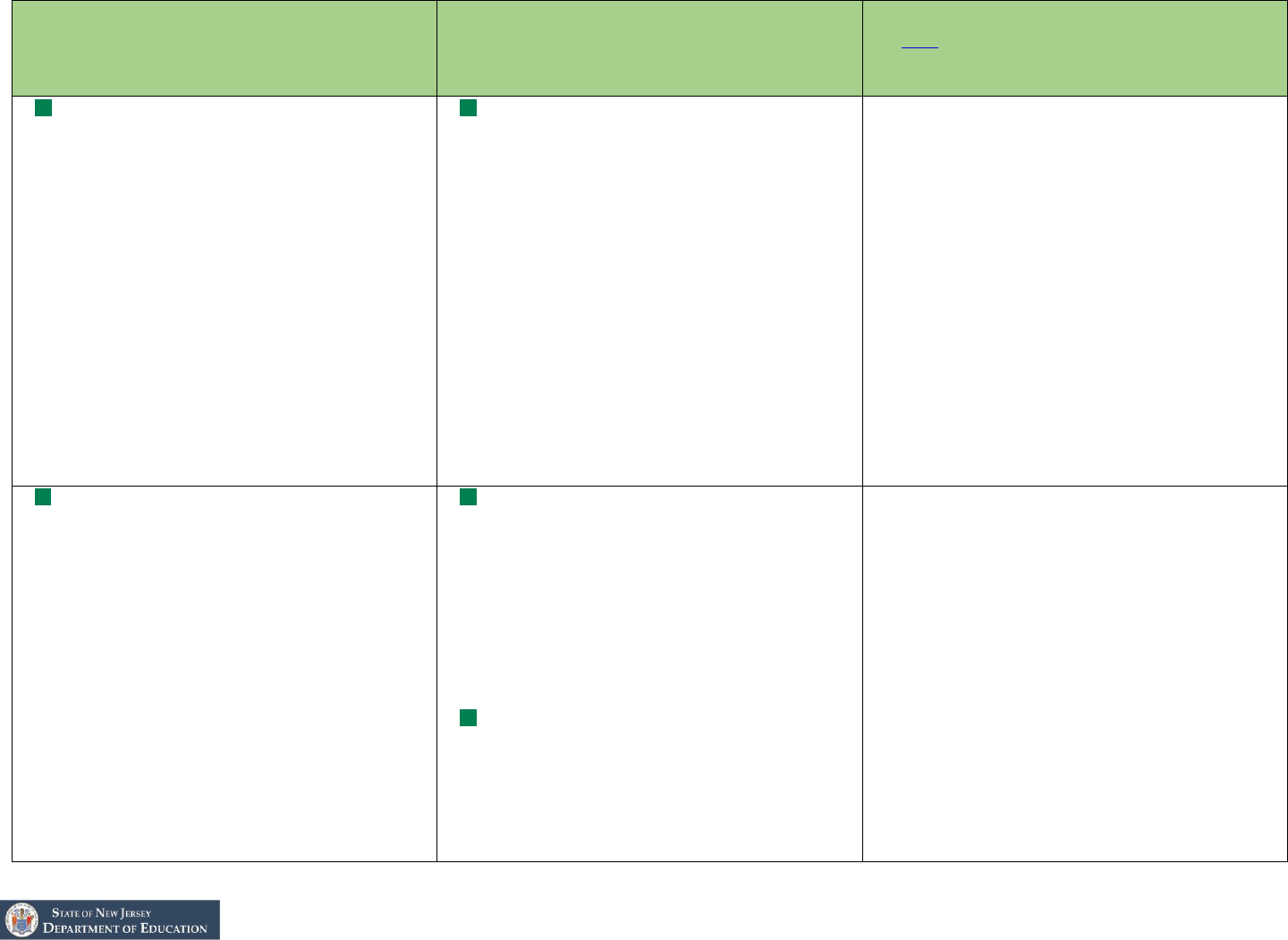
Grade 2: New Jersey Student Learning Standards for Mathematics - Prerequisite Standards and Learning Objectives
8
Updated February 2021
Standard and Student Learning
Objectives
Previous Grade(s) Standards and Student
Learning Objectives
Instructional Considerations
SAP recommendation to preserve or reduce
time in 20-21 as compared to a typical year
2.NBT.A.2 Count within 1000; skip-count
by 5s, 10s, and 100s.
We are learning to/that…
▪ count within 1000
▪ skip count by fives
▪ skip count by tens
▪ skip count by hundreds
1.NBT.A.1 Count to 120, starting at any
number less than 120. In this range, read and
write numerals and represent a number of
objects with a written numeral.
We have learned to/that…
▪ count to 120
▪ represent objects with a written number
in sets within 120 objects
Emphasize the conceptual understanding of
three-digit numbers (as detailed in
1.NBT.A.1).
Integrate lessons and practice on counting,
reading/writing, and comparing numbers
(2.NBT.A.2, 2.NBT.A.3, 2.NBT.A.4) into
the work of place value.
Limit the amount of required student practice
on counting by ones.
Note: While the standards in cluster
2.NBT.A are Major Work of the Grade,
during the 2020-21 school year, it is
recommended that they receive lighter
treatment.
2.NBT.A.3 Read and write numbers to
1000 using base-ten numerals, number
names, and expanded form.
We are learning to/that…
▪ read numbers to 1000 using base-ten
numerals
▪ write numbers to 1000 using base-ten
numerals
▪ read numbers to 1000 using expanded
form and number names
▪ write numbers to 1000 using expanded
form and number names
1.NBT.A.1 Count to 120, starting at any
number less than 120. In this range, read and
write numerals and represent a number of
objects with a written numeral.
We have learned to/that…
▪ read numbers up to 120
▪ write numbers up to 120
1.NBT.B.2 Understand that the two digits
of a two-digit number represent amounts of
tens and ones. Understand the following as
special cases:
Emphasize the conceptual understanding of
three-digit numbers (as detailed in
1.NBT.A.1).
Integrate lessons and practice on counting,
reading/writing, and comparing numbers
(2.NBT.A.2, 2.NBT.A.3, 2.NBT.A.4) into
the work of place value.
Limit the amount of required student practice
on counting by ones, reading/writing and
comparing numbers.
Note: While the standards in cluster
2.NBT.A are Major Work of the Grade,
during the 2020-21 school year, it is
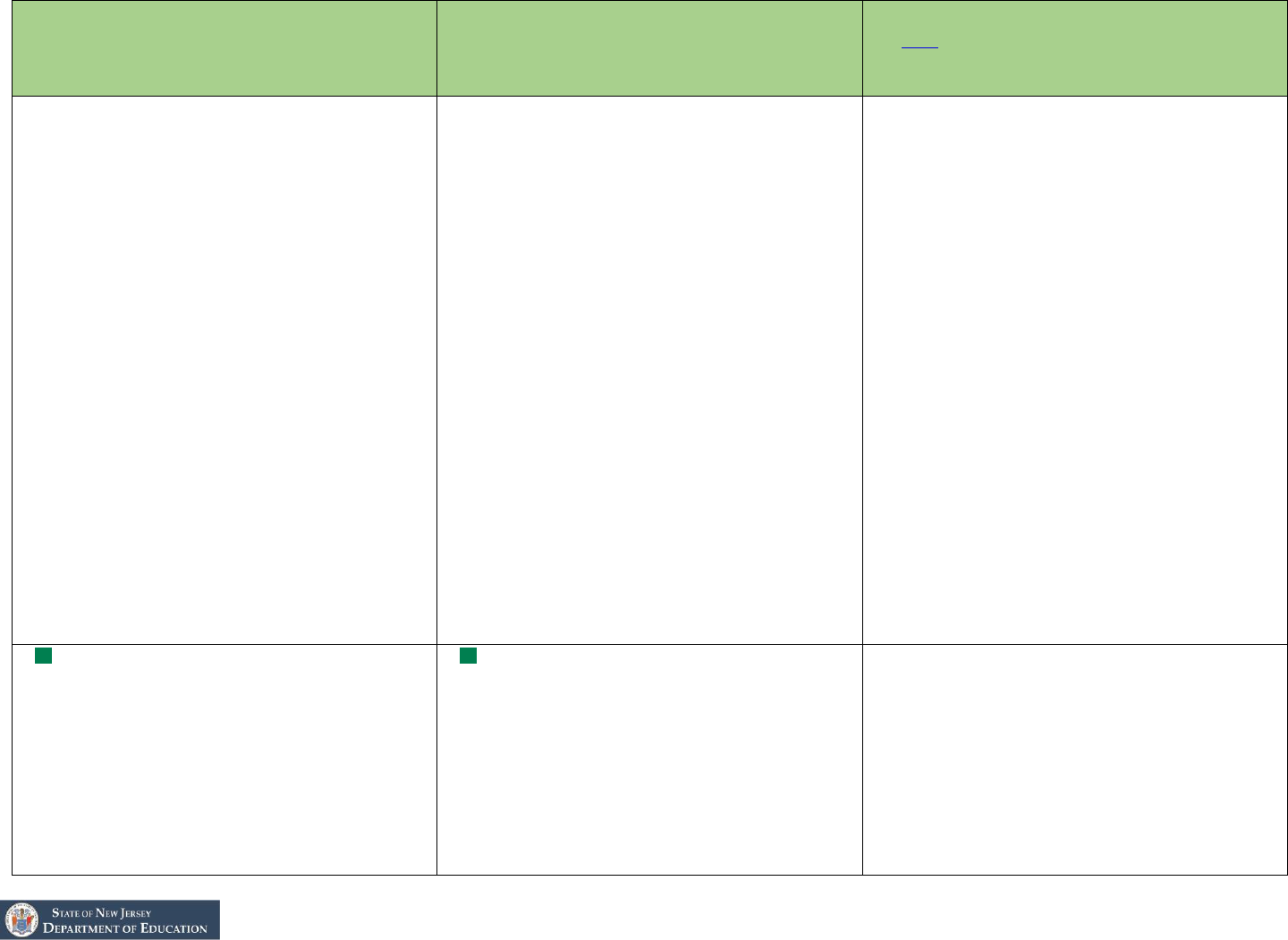
Grade 2: New Jersey Student Learning Standards for Mathematics - Prerequisite Standards and Learning Objectives
9
Updated February 2021
Standard and Student Learning
Objectives
Previous Grade(s) Standards and Student
Learning Objectives
Instructional Considerations
SAP recommendation to preserve or reduce
time in 20-21 as compared to a typical year
a. 10 can be thought of as a bundle of ten
ones—called a “ten.”
b. The numbers from 11 to 19 are composed
of a ten and one, two, three, four, five, six,
seven, eight, or nine ones.
c. The numbers 10, 20, 30, 40, 50, 60, 70,
80, 90 refer to one, two, three, four, five, six,
seven, eight, or nine tens (and 0 ones).
We have learned to/that…
▪ 10 can be thought of as a bundle of ten
ones called a “ten”
▪ the numbers 11 to 19 are made up of one
ten and one, two, three, four, five, six,
seven, eight, or nine ones
▪ in a two-digit number, one digit
represents the amount of tens and the
other digit represents the amount of ones
▪ the numbers 10, 20, 30, 40, 50, 60, 70,
80, 90 are made up of some tens and 0
ones
recommended that they receive lighter
treatment.
2.NBT.A.4 Compare two three-digit
numbers based on meanings of the hundreds,
tens, and ones digits, using >, =, and <
symbols to record the results of comparisons.
We are learning to/that…
▪ compare two three-digit numbers using
place value understanding and record the
results using the symbols >, =, <
1.NBT.B.3 Compare two two-digit
numbers based on meanings of the tens and
ones digits, recording the results of
comparisons with the symbols >, =, and <.
We have learned to/that…
▪ compare two two-digit numbers using the
meanings of the tens and ones digits
Emphasize the conceptual understanding of
three-digit numbers (as detailed in
1.NBT.A.1).
Integrate lessons and practice on counting,
reading/writing, and comparing numbers
(2.NBT.A.2, 2.NBT.A.3, 2.NBT.A.4) into
the work of place value.
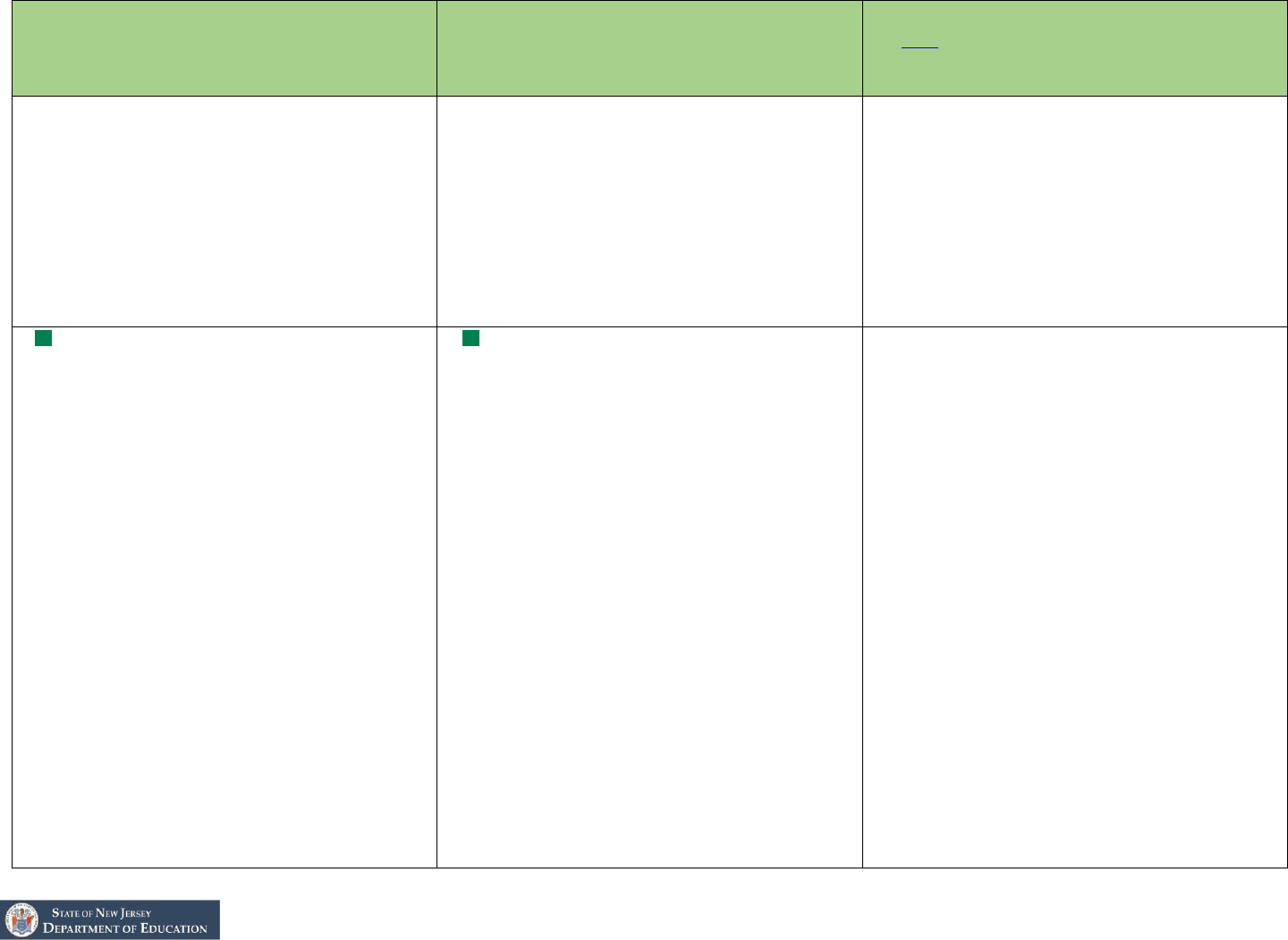
Grade 2: New Jersey Student Learning Standards for Mathematics - Prerequisite Standards and Learning Objectives
10
Updated February 2021
Standard and Student Learning
Objectives
Previous Grade(s) Standards and Student
Learning Objectives
Instructional Considerations
SAP recommendation to preserve or reduce
time in 20-21 as compared to a typical year
▪ compare two numbers using the symbols
<, >, and =
Limit the amount of required student practice
on counting by ones, reading/writing and
comparing numbers.
Note: While the standards in cluster
2.NBT.A are Major Work of the Grade,
during the 2020-21 school year, it is
recommended that they receive lighter
treatment
2.NBT.B.5 Fluently add and subtract
within 100 using strategies based on place
value, properties of operations, and/or the
relationship between addition and
subtraction.
We are learning to/that…
▪ add and subtract within 100 using
strategies based on place value,
properties of operations, and/or the
relationship between addition and
subtraction, with accuracy and efficiency
1.NBT.C.4 Add within 100, including
adding a two-digit number and a one-digit
number, and adding a two-digit number and
a multiple of 10, using concrete models (e.g.,
base ten blocks) or drawings and strategies
based on place value, properties of
operations, and/or the relationship between
addition and subtraction; relate the strategy
to a written method and explain the
reasoning used. Understand that in adding
two-digit numbers, one adds tens and tens,
ones and ones; and sometimes it is necessary
to compose a ten.
We have learned to/that…
▪ compose tens when adding two-digit
numbers, if necessary
▪ when adding two-digit numbers, one
adds tens and tens, ones and ones
▪ add a two-digit number and a one-digit
number within 100 using strategies based
on place value, properties of operations,
Prioritize strategies based on place value in
written work to strengthen the progression
toward fluency with multi-digit addition and
subtraction.
Incorporate foundational work on addition
and subtraction within 100 from grade 1
(1.NBT.C) to support the addition and
subtraction work of grade 2.
Note that grade 2 students are not expected
to be fluent with three-digit sums and
differences; repetitive fluency exercises are
not required.
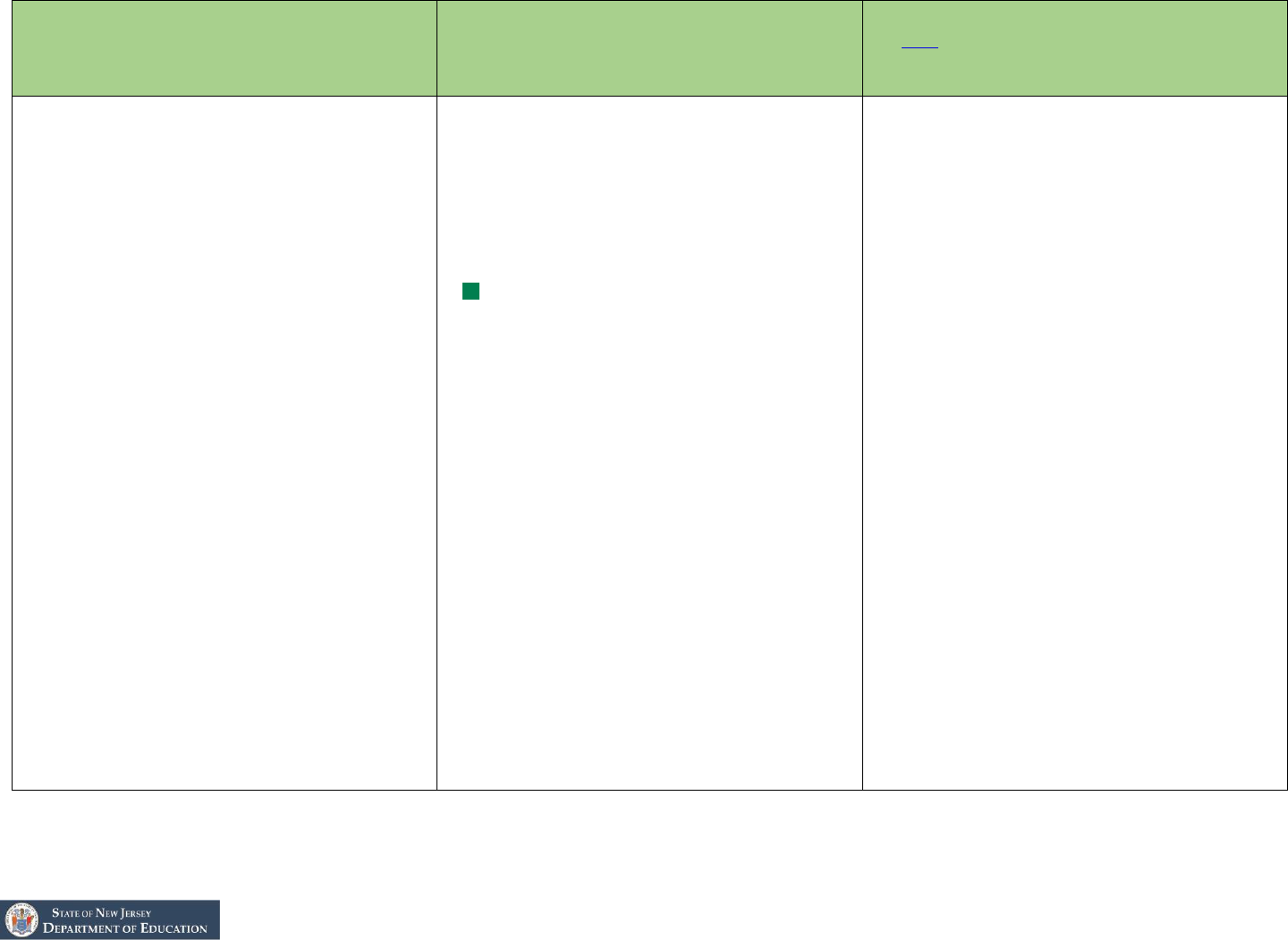
Grade 2: New Jersey Student Learning Standards for Mathematics - Prerequisite Standards and Learning Objectives
11
Updated February 2021
Standard and Student Learning
Objectives
Previous Grade(s) Standards and Student
Learning Objectives
Instructional Considerations
SAP recommendation to preserve or reduce
time in 20-21 as compared to a typical year
and/or the relationship between addition
and subtraction
▪ add a two-digit number and a multiple of
10, within 100, using strategies based on
place value, properties of operations,
and/or the relationship between addition
and subtraction
1.NBT.C.6 Subtract multiples of 10 in the
range 10–90 from multiples of 10 in the
range 10–90 (positive or zero differences),
using concrete models or drawings and
strategies based on place value, properties of
operations, and/or the relationship between
addition and subtraction; relate the strategy
to a written method and explain the
reasoning used.
We have learned to/that…
▪ subtract multiples of 10 from multiples of
10 using strategies based on place value
or properties of operations (multiples of
10 less than or equal to 90)
▪ explain the reasoning used when
subtracting multiples of 10 from
multiples of 10 (multiples of 10 less than
or equal to 90)
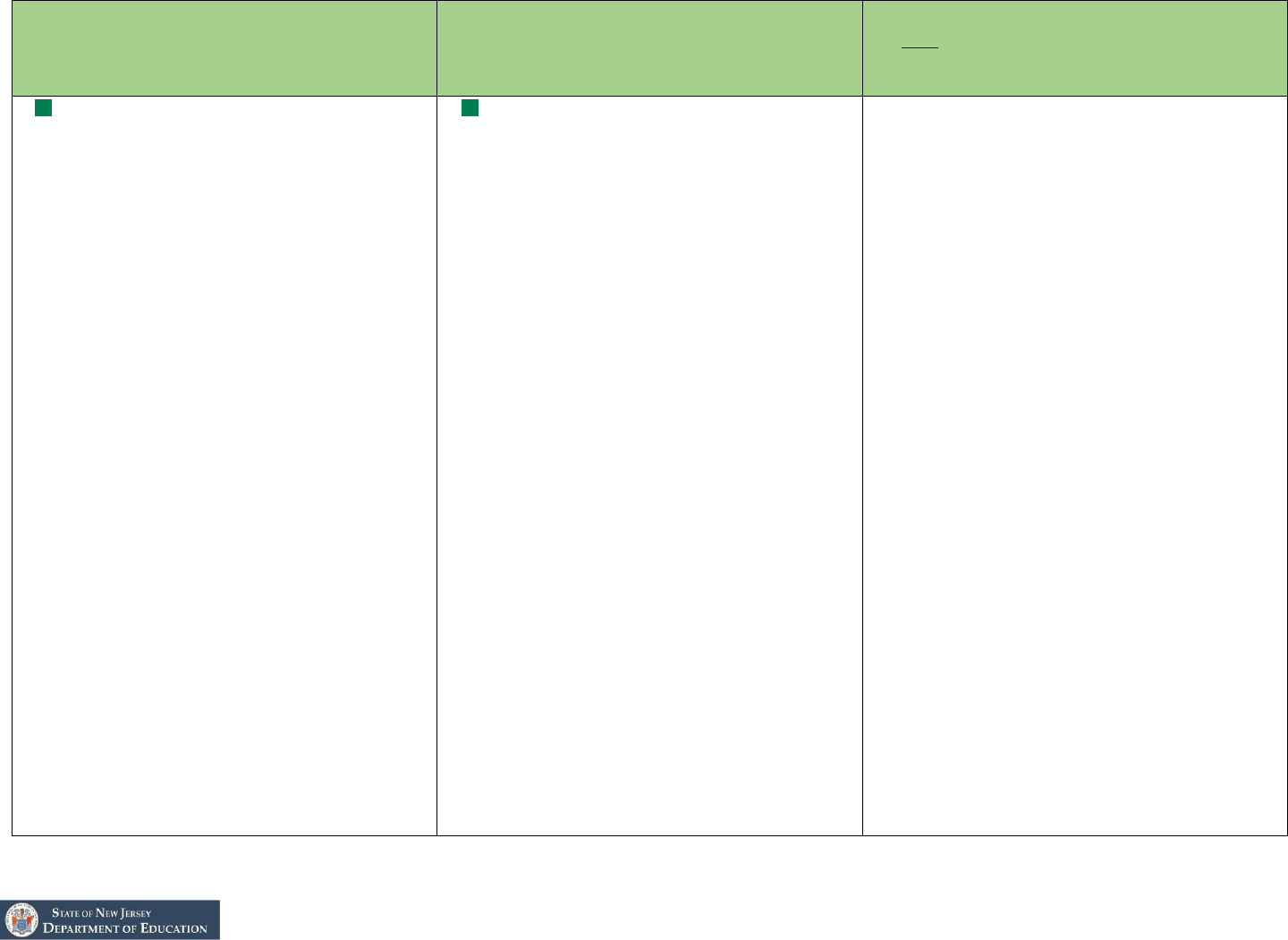
Grade 2: New Jersey Student Learning Standards for Mathematics - Prerequisite Standards and Learning Objectives
12
Updated February 2021
Standard and Student Learning
Objectives
Previous Grade(s) Standards and Student
Learning Objectives
Instructional Considerations
SAP recommendation to preserve or reduce
time in 20-21 as compared to a typical year
2.NBT.B.6 Add up to four two-digit
numbers using strategies based on place
value and properties of operations.
We are learning to/that…
▪ add up to four two-digit numbers using
place value strategies and properties of
operations
1.NBT.C.4 Add within 100, including
adding a two-digit number and a one-digit
number, and adding a two-digit number and
a multiple of 10, using concrete models (e.g.,
base ten blocks) or drawings and strategies
based on place value, properties of
operations, and/or the relationship between
addition and subtraction; relate the strategy
to a written method and explain the
reasoning used. Understand that in adding
two-digit numbers, one adds tens and tens,
ones and ones; and sometimes it is necessary
to compose a ten.
We have learned to/that…
▪ when adding two-digit numbers, one
adds tens and tens, ones and ones
▪ add a two-digit number and a one-digit
number within 100 using strategies based
on place value, properties of operations,
and/or the relationship between addition
and subtraction
▪ add a two-digit number and a multiple of
10, within 100, using strategies based on
place value, properties of operations,
and/or the relationship between addition
and subtraction
Prioritize strategies based on place value in
written work to strengthen the progression
toward fluency with multi-digit addition and
subtraction.
Incorporate foundational work on addition
and subtraction within 100 from grade 1
(1.NBT.C) to support the addition and
subtraction work of grade 2.
Note that grade 2 students are not expected
to be fluent with three-digit sums and
differences; repetitive fluency exercises are
not required.
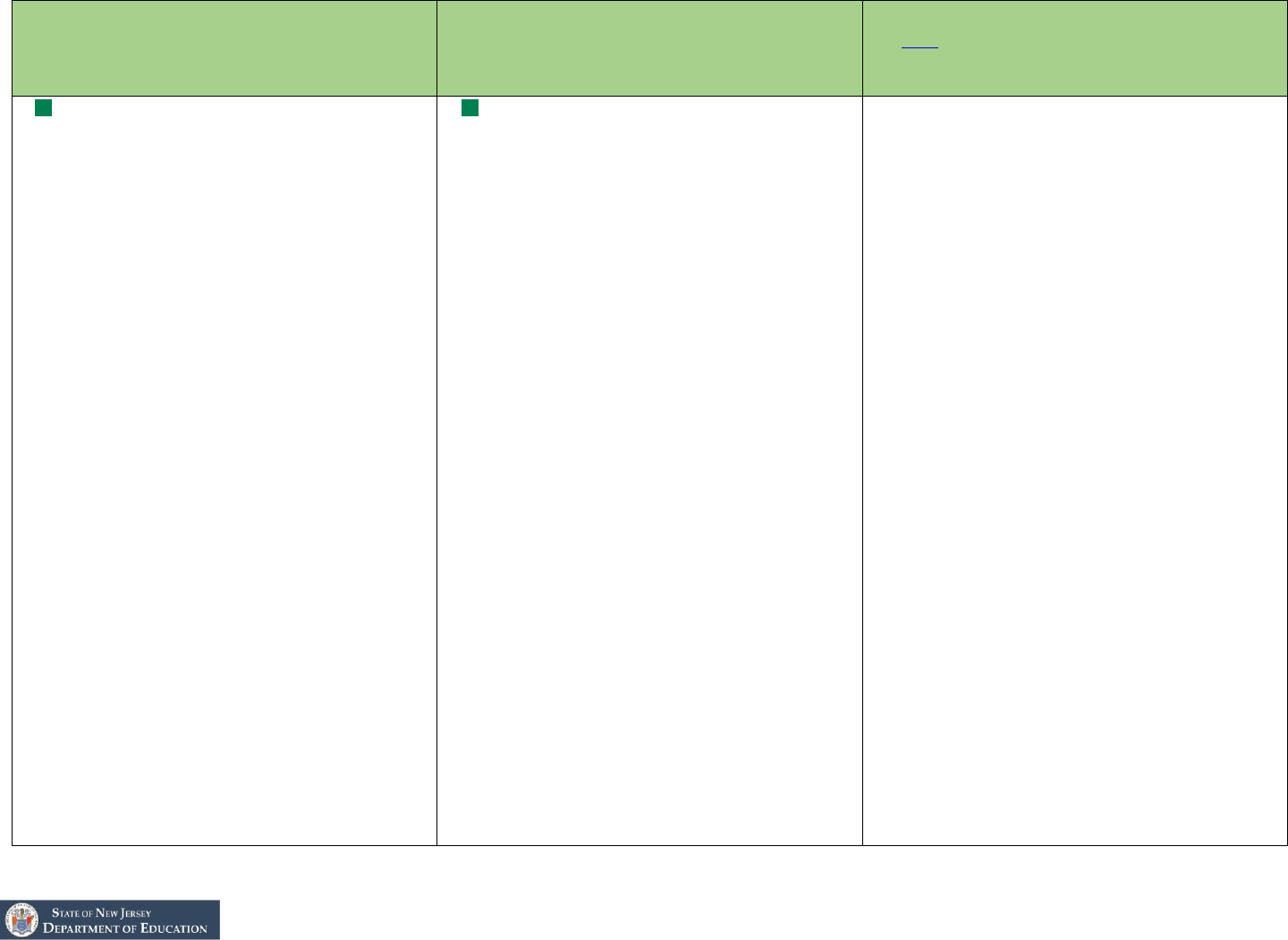
Grade 2: New Jersey Student Learning Standards for Mathematics - Prerequisite Standards and Learning Objectives
13
Updated February 2021
Standard and Student Learning
Objectives
Previous Grade(s) Standards and Student
Learning Objectives
Instructional Considerations
SAP recommendation to preserve or reduce
time in 20-21 as compared to a typical year
2.NBT.B.7 Add and subtract within 1000,
using concrete models or drawings and
strategies based on place value, properties of
operations, and/or the relationship between
addition and subtraction; relate the strategy
to a written method. Understand that in
adding or subtracting three-digit numbers,
one adds or subtracts hundreds and hundreds,
tens and tens, ones and ones; and sometimes
it is necessary to compose or decompose tens
or hundreds.
We are learning to/that…
▪ use concrete models and a place value
strategy to add and subtract within 1000,
and relate the written strategy to the
model
▪ use drawings and a place value strategy
to add and subtract within 1000, and
relate the written strategy to the drawing
▪ use concrete models and a strategy based
on properties of operations and/or the
relationship between addition and
subtraction to add and subtract within
1000, and relate the written strategy to
the model
▪ use drawings and a strategy based on
properties of operations and/or the
relationship between addition and
subtraction to add and subtract within
1.NBT.C.4 Add within 100, including
adding a two-digit number and a one-digit
number, and adding a two-digit number and
a multiple of 10, using concrete models (e.g.,
base ten blocks) or drawings and strategies
based on place value, properties of
operations, and/or the relationship between
addition and subtraction; relate the strategy
to a written method and explain the
reasoning used. Understand that in adding
two-digit numbers, one adds tens and tens,
ones and ones; and sometimes it is necessary
to compose a ten.
We have learned to/that…
▪ add a two-digit number and a one-digit
number within 100 using concrete
models (e.g., base ten blocks) or
drawings
▪ add a two-digit number and a one-digit
number within 100 using strategies based
on place value, properties of operations,
and/or the relationship between addition
and subtraction
▪ add a two-digit number and a multiple of
10, within 100, using concrete models
(e.g., base ten blocks) or drawings
▪ add a two-digit number and a multiple of
10, within 100, using strategies based on
place value, properties of operations,
Prioritize strategies based on place value in
written work to strengthen the progression
toward fluency with multi-digit addition and
subtraction.
Incorporate foundational work on addition
and subtraction within 100 from grade 1
(1.NBT.C) to support the addition and
subtraction work of grade 2.
Note that grade 2 students are not expected
to be fluent with three-digit sums and
differences; repetitive fluency exercises are
not required.
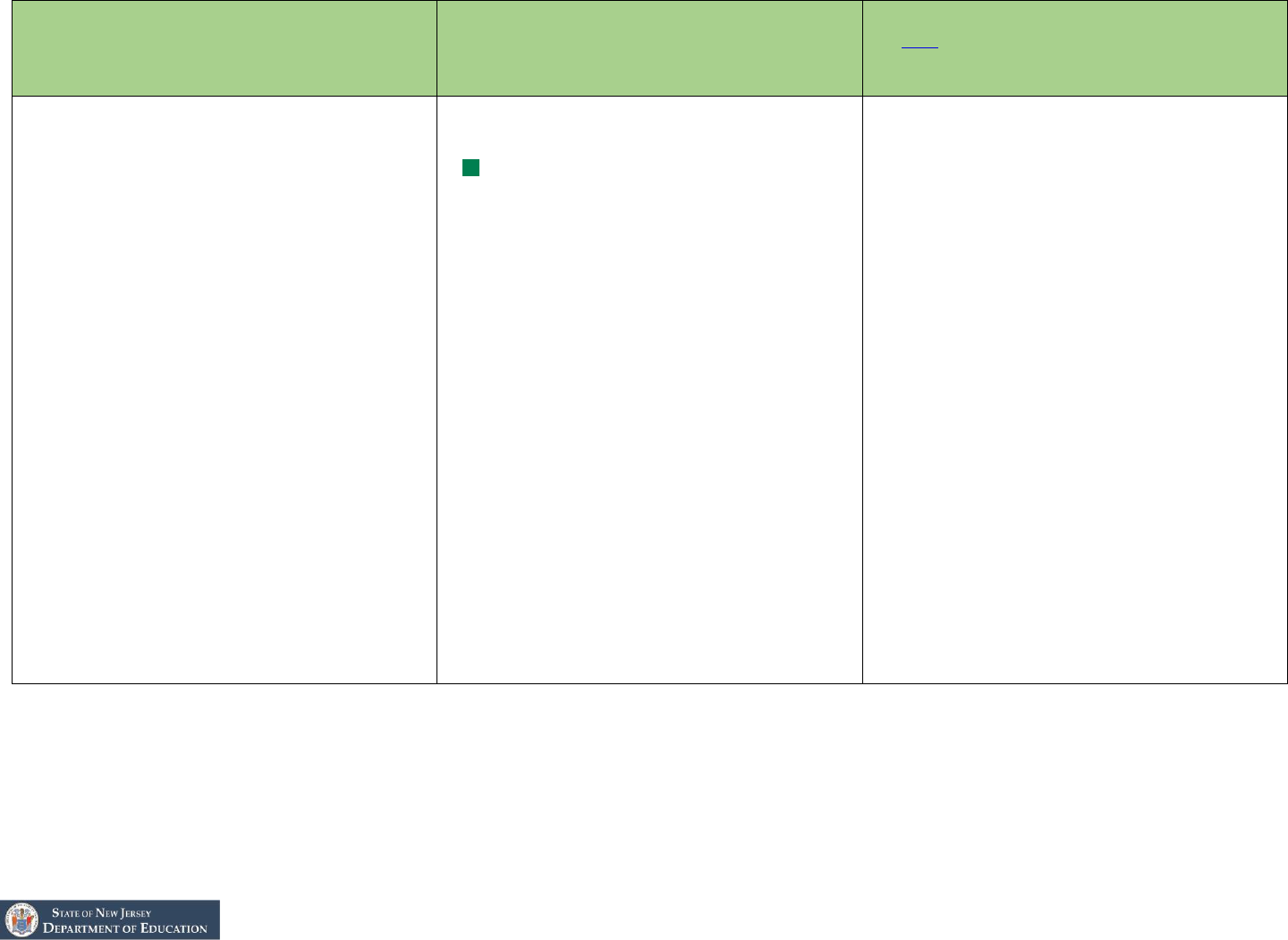
Grade 2: New Jersey Student Learning Standards for Mathematics - Prerequisite Standards and Learning Objectives
14
Updated February 2021
Standard and Student Learning
Objectives
Previous Grade(s) Standards and Student
Learning Objectives
Instructional Considerations
SAP recommendation to preserve or reduce
time in 20-21 as compared to a typical year
1000, and relate the written strategy to
the drawing
and/or the relationship between addition
and subtraction
1.NBT.C.6 Subtract multiples of 10 in the
range 10–90 from multiples of 10 in the
range 10–90 (positive or zero differences),
using concrete models or drawings and
strategies based on place value, properties of
operations, and/or the relationship between
addition and subtraction; relate the strategy
to a written method and explain the
reasoning used.
We have learned to/that…
▪ subtract multiples of 10 from multiples of
10 using concrete models or drawings
▪ subtract multiples of 10 from multiples of
10 using strategies based on place value
or properties of operations (multiples of
10 less than or equal to 90)
▪ explain the reasoning used when
subtracting multiples of 10 from
multiples of 10 (multiples of 10 less than
or equal to 90)
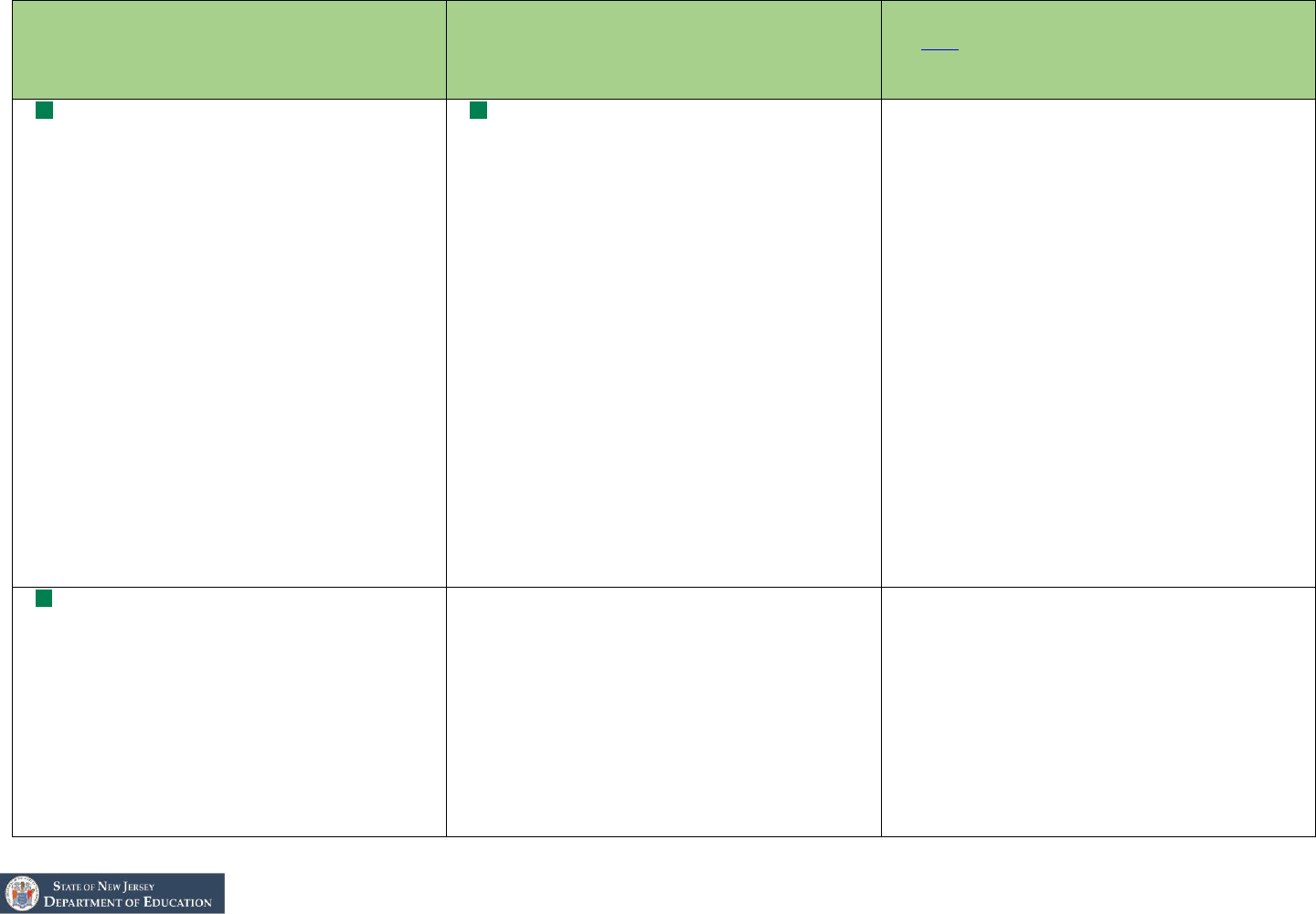
Grade 2: New Jersey Student Learning Standards for Mathematics - Prerequisite Standards and Learning Objectives
15
Updated February 2021
Domain: Measurement and Data
Standard and Student Learning
Objectives
Previous Grade(s) Standards and Student
Learning Objectives
Instructional Considerations
SAP recommendation to preserve or reduce
time in 20-21 as compared to a typical year
2.MD.A.1 Measure the length of an object
by selecting and using appropriate tools such
as rulers, yardsticks, meter sticks, and
measuring tapes.
We are learning to/that…
▪ measure lengths of objects after
selecting appropriate tools such as
rulers, yardsticks, meter sticks, and
measuring tapes
1.MD.A.2 Express the length of an object
as a whole number of length units, by laying
multiple copies of a shorter object (the length
unit) end to end; understand that the length
measurement of an object is the number of
same-size length units that span it with no
gaps or overlaps. Limit to contexts where the
object being measured is spanned by a whole
number of length units with no gaps or
overlaps.
We have learned to/that…
▪ the length of an object is the number of
same-size length units that span it with
no gaps or overlaps
▪ express the length of an object as a
whole number of length units, by laying
multiple copies of a shorter object end to
end
Integrate lessons and practice on comparing
and estimating lengths (2.MD.A.2,
2.MD.A.3, 2.MD.A.4) into the work of
measuring length with tools (2.MD.A.1) in
order to reduce the amount of time spent on
this cluster. Limit the amount of required
student practice.
Note: While the standards in cluster 2.MD.A
are Major Work of the Grade, during the
2020-21 school year, it is recommended that
they receive lighter treatment.
2.MD.A.2 Measure the length of an object
twice, using length units of different lengths
for the two measurements; describe how the
two measurements relate to the size of the
unit chosen.
We are learning to/that…
▪ measure the length of an object twice
using different units of measure
n/a
Integrate lessons and practice on comparing
and estimating lengths (2.MD.A.2,
2.MD.A.3, 2.MD.A.4) into the work of
measuring length with tools (2.MD.A.1) in
order to reduce the amount of time spent on
this cluster. Limit the amount of required
student practice.
Note: While the standards in cluster 2.MD.A
are Major Work of the Grade, during the
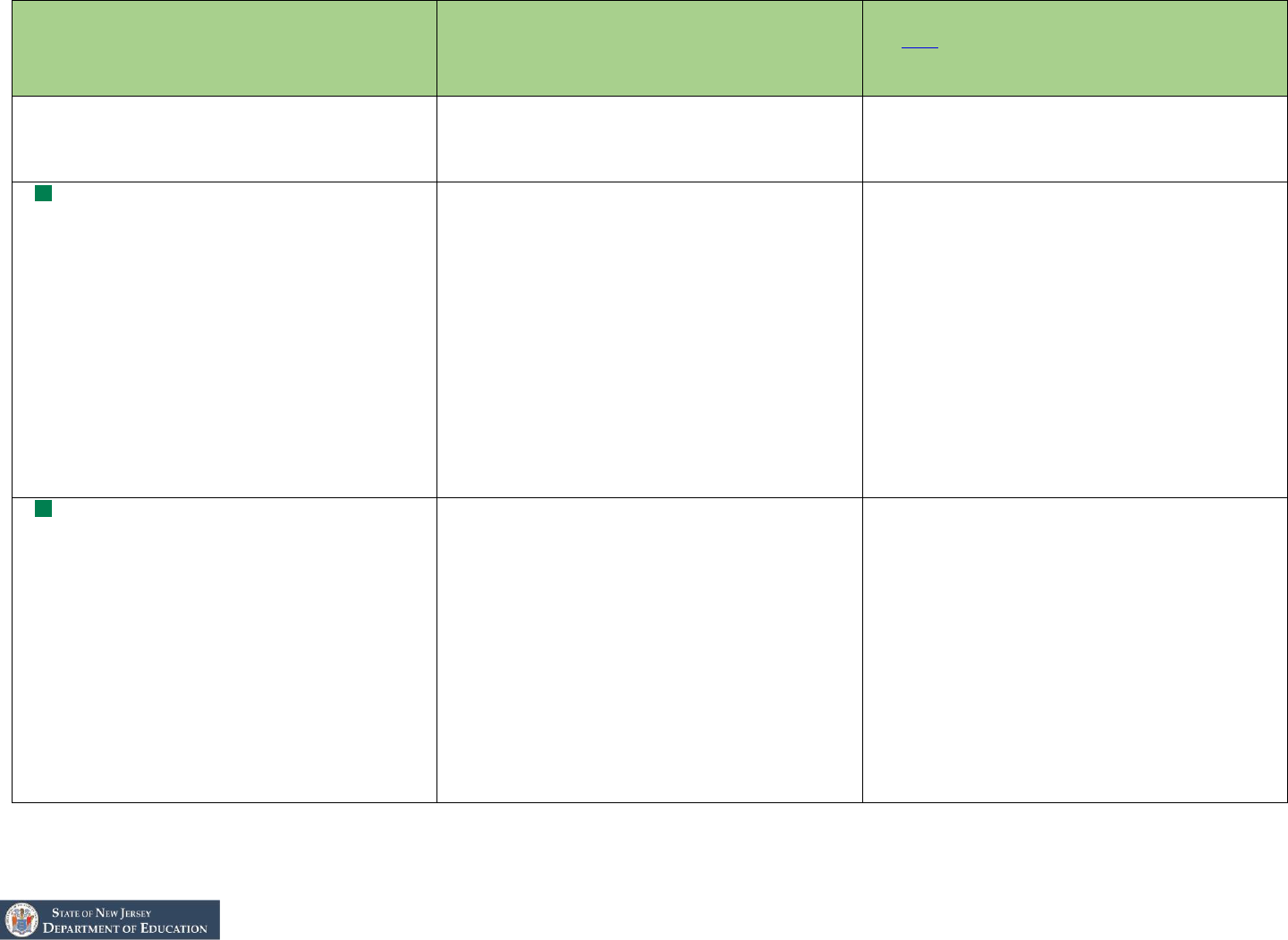
Grade 2: New Jersey Student Learning Standards for Mathematics - Prerequisite Standards and Learning Objectives
16
Updated February 2021
Standard and Student Learning
Objectives
Previous Grade(s) Standards and Student
Learning Objectives
Instructional Considerations
SAP recommendation to preserve or reduce
time in 20-21 as compared to a typical year
describe how two different measurements of
an object relate to the size of the
measurement unit chosen
2020-21 school year, it is recommended that
they receive lighter treatment.
2.MD.A.3 Estimate lengths using units of
inches, feet, centimeters, and meters.
We are learning to/that…
▪ estimate lengths of objects using the
units of inches, feet, centimeters, or
meters
n/a
Integrate lessons and practice on comparing
and estimating lengths (2.MD.A.2,
2.MD.A.3, 2.MD.A.4) into the work of
measuring length with tools (2.MD.A.1) in
order to reduce the amount of time spent on
this cluster. Limit the amount of required
student practice.
Note: While the standards in cluster 2.MD.A
are Major Work of the Grade, during the
2020-21 school year, it is recommended that
they receive lighter treatment.
2.MD.A.4 Measure to determine how
much longer one object is than another,
expressing the length difference in terms of a
standard length unit
We are learning to/that…
▪ measure to determine how much longer
one object is than the other and express
the difference in length using a standard
unit of length
n/a
Integrate lessons and practice on comparing
and estimating lengths (2.MD.A.2,
2.MD.A.3, 2.MD.A.4) into the work of
measuring length with tools (2.MD.A.1) in
order to reduce the amount of time spent on
this cluster. Limit the amount of required
student practice.
Note: While the standards in cluster 2.MD.A
are Major Work of the Grade, during the
2020-21 school year, it is recommended that
they receive lighter treatment.
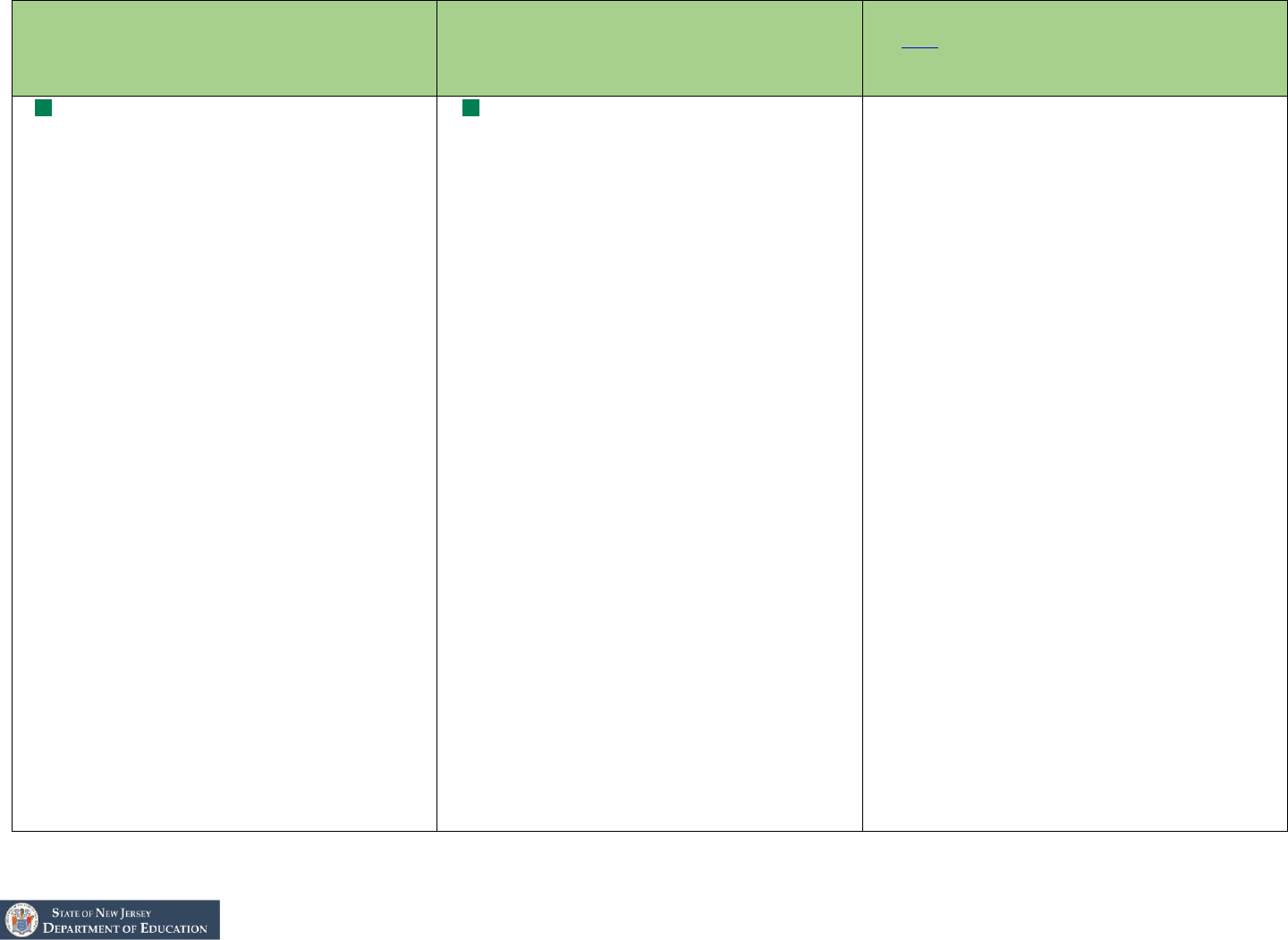
Grade 2: New Jersey Student Learning Standards for Mathematics - Prerequisite Standards and Learning Objectives
17
Updated February 2021
Standard and Student Learning
Objectives
Previous Grade(s) Standards and Student
Learning Objectives
Instructional Considerations
SAP recommendation to preserve or reduce
time in 20-21 as compared to a typical year
2.MD.B.5 Use addition and subtraction
within 100 to solve word problems involving
lengths that are given in the same units, e.g.,
by using drawings (such as drawings of
rulers) and equations with a symbol for the
unknown number to represent the problem.
We are learning to/that…
▪ add and subtract within 100 to solve
word problems that involve lengths of
the same units
▪ use equations with a symbol for the
unknown and drawings, such as
drawings of rulers, to represent the
problem
1.NBT.C.4 Add within 100, including
adding a two-digit number and a one-digit
number, and adding a two-digit number and
a multiple of 10, using concrete models (e.g.,
base ten blocks) or drawings and strategies
based on place value, properties of
operations, and/or the relationship between
addition and subtraction; relate the strategy
to a written method and explain the
reasoning used. Understand that in adding
two-digit numbers, one adds tens and tens,
ones and ones; and sometimes it is necessary
to compose a ten.
We have learned to/that…
▪ compose tens when adding two-digit
numbers, if necessary
▪ when adding two-digit numbers, one
adds tens and tens, ones and ones
▪ add a two-digit number and a one-digit
number within 100 using strategies based
on place value, properties of operations,
and/or the relationship between addition
and subtraction
▪ add a two-digit number and a multiple of
10, within 100, using strategies based on
place value, properties of operations,
and/or the relationship between addition
and subtraction
Ensure word problems represent all grade 2
problem types and refer to guidance for
2.OA.A.
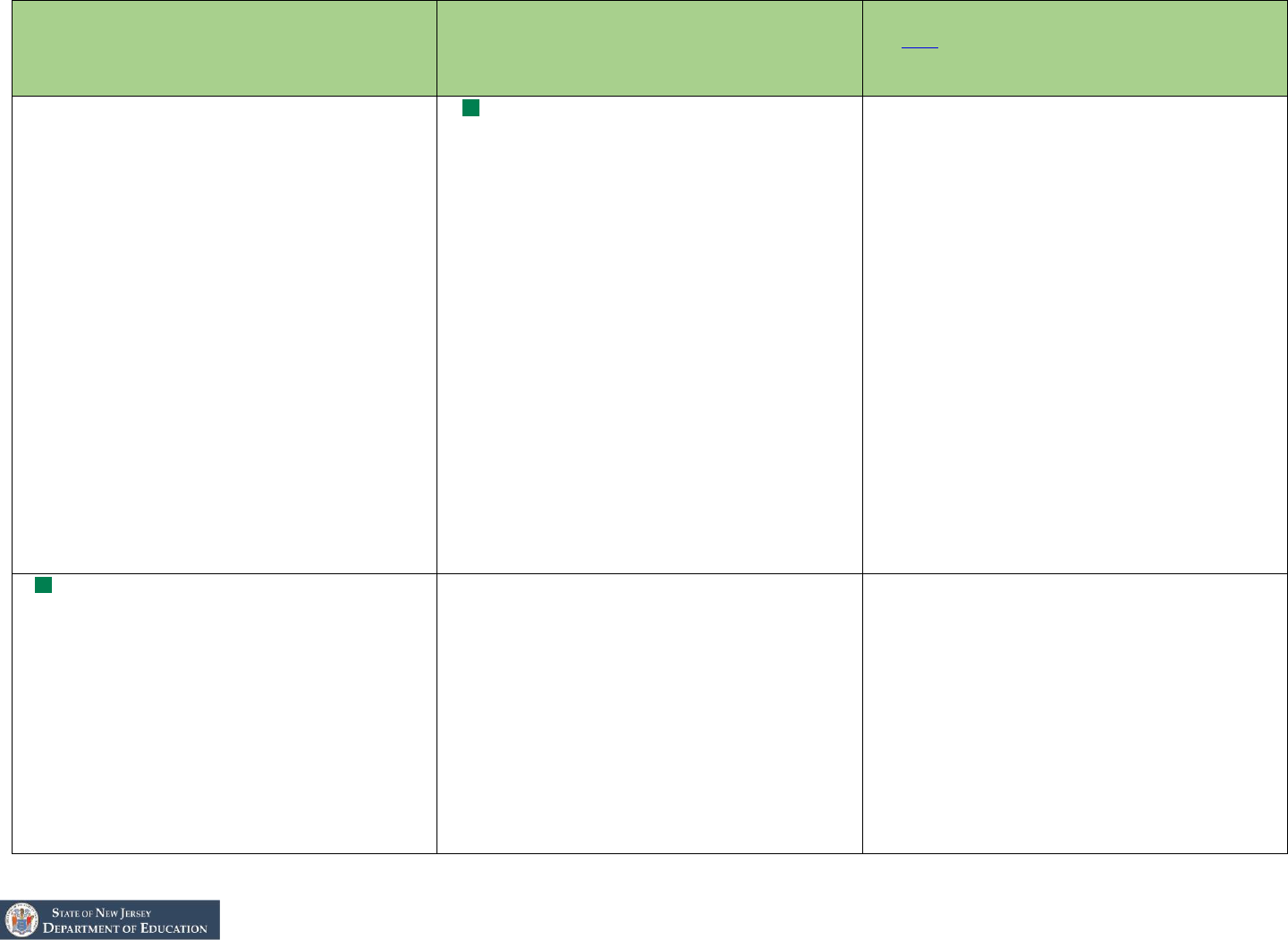
Grade 2: New Jersey Student Learning Standards for Mathematics - Prerequisite Standards and Learning Objectives
18
Updated February 2021
Standard and Student Learning
Objectives
Previous Grade(s) Standards and Student
Learning Objectives
Instructional Considerations
SAP recommendation to preserve or reduce
time in 20-21 as compared to a typical year
1.NBT.C.6 Subtract multiples of 10 in the
range 10–90 from multiples of 10 in the
range 10–90 (positive or zero differences),
using concrete models or drawings and
strategies based on place value, properties of
operations, and/or the relationship between
addition and subtraction; relate the strategy
to a written method and explain the
reasoning used.
We have learned to/that…
▪ subtract multiples of 10 from multiples of
10 using strategies based on place value
or properties of operations (multiples of
10 less than or equal to 90)
▪ explain the reasoning used when
subtracting multiples of 10 from
multiples of 10 (multiples of 10 less than
or equal to 90)
2.MD.B.6 Represent whole numbers as
lengths from 0 on a number line diagram
with equally spaced points corresponding to
the numbers 0,1,2 …, and represent whole-
number sums and differences within 100 on a
number line diagram
We are learning to/that…
▪ use equally spaced points of a number
line to represent whole numbers as
lengths from 0
n/a
For curricula and lessons that are well
aligned to representing lengths on number
line diagrams as detailed in this standard, no
special considerations for shifting how time
is dedicated are recommended.
Time spent on instruction and practice
should not be reduced.
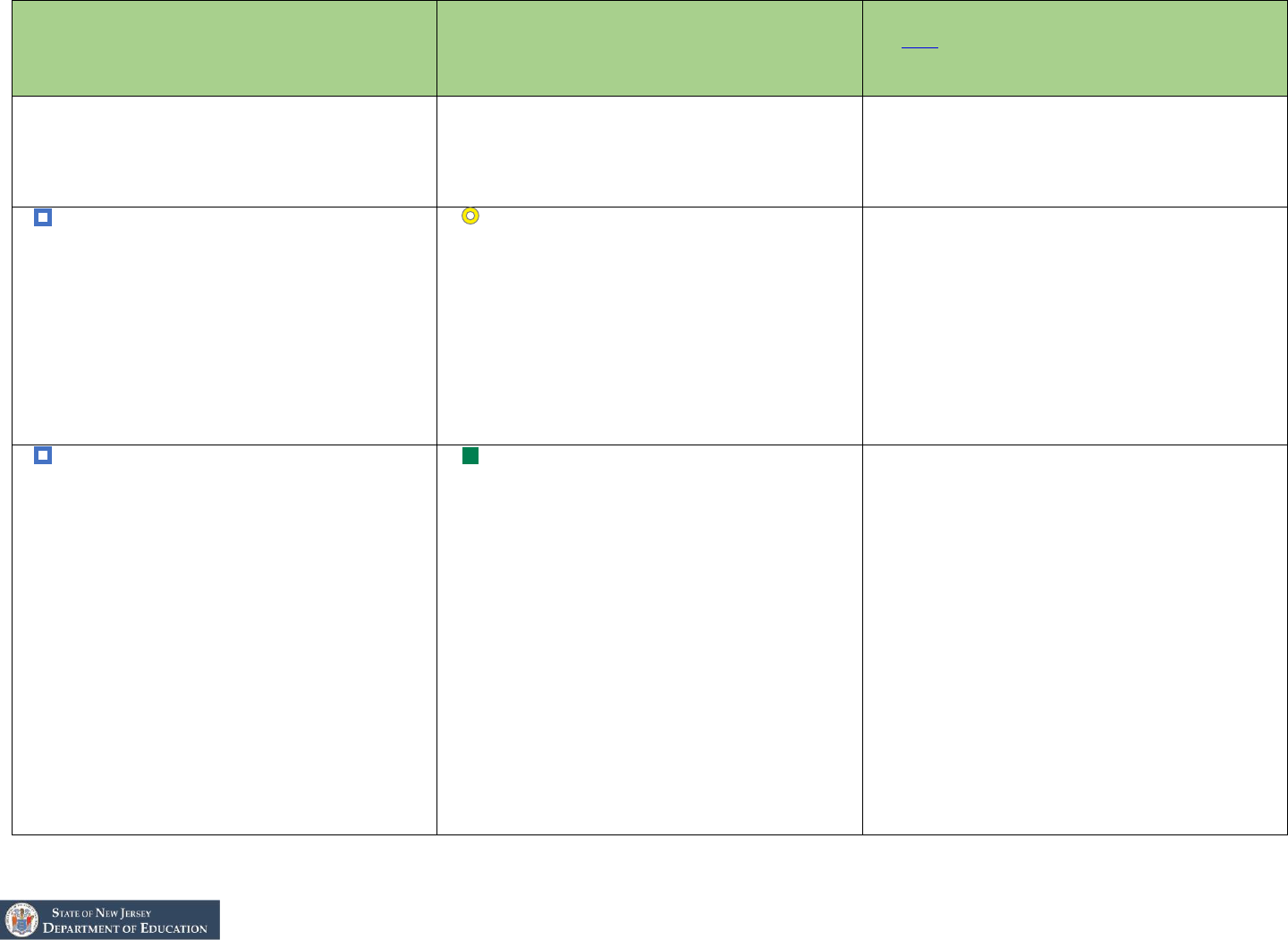
Grade 2: New Jersey Student Learning Standards for Mathematics - Prerequisite Standards and Learning Objectives
19
Updated February 2021
Standard and Student Learning
Objectives
Previous Grade(s) Standards and Student
Learning Objectives
Instructional Considerations
SAP recommendation to preserve or reduce
time in 20-21 as compared to a typical year
▪ represent whole number sums within 100
on a number line diagram
▪ represent whole number differences
within 100 on a number line diagram
2.MD.C.7 Tell and write time from analog
and digital clocks to the nearest five minutes,
using a.m. and p.m.
We are learning to/that…
▪ use analog and digital clocks to tell time
to the nearest five minutes using a.m. and
p.m.
1.MD.B.3 Tell and write time in hours and
half-hours using analog and digital clocks.
We have learned to/that…
▪ tell and write time to the hour using
analog and digital clocks
▪ tell and write time to the half-hour using
analog and digital clocks
Combine lessons in order to reduce the
amount of time spent on time and money.
Emphasize denominations that support place
value understanding such as penny-dime-
dollar.
Limit the amount of required student
practice.
2.MD.C.8. Solve word problems
involving dollar bills, quarters, dimes,
nickels, and pennies, using $ and ¢ symbols
appropriately. Example: If you have 2 dimes
and 3 pennies, how many cents do you have?
We are learning to/that…
▪ determine the total amount of money by
counting combinations of dollar bills,
quarters, dimes, nickels, and pennies
using the $ and ¢ symbols appropriately
▪ solve word problems involving dollar
bills, quarters, dimes, nickels, and
pennies using the $ and ¢ symbols
appropriately
1.NBT.C.4 Add within 100, including
adding a two-digit number and a one-digit
number, and adding a two-digit number and
a multiple of 10, using concrete models (e.g.,
base ten blocks) or drawings and strategies
based on place value, properties of
operations, and/or the relationship between
addition and subtraction; relate the strategy
to a written method and explain the
reasoning used. Understand that in adding
two-digit numbers, one adds tens and tens,
ones and ones; and sometimes it is necessary
to compose a ten.
We have learned to/that…
Combine lessons in order to reduce the
amount of time spent on time and money.
Emphasize denominations that support place
value understanding such as penny-dime-
dollar.
Limit the amount of required student
practice.
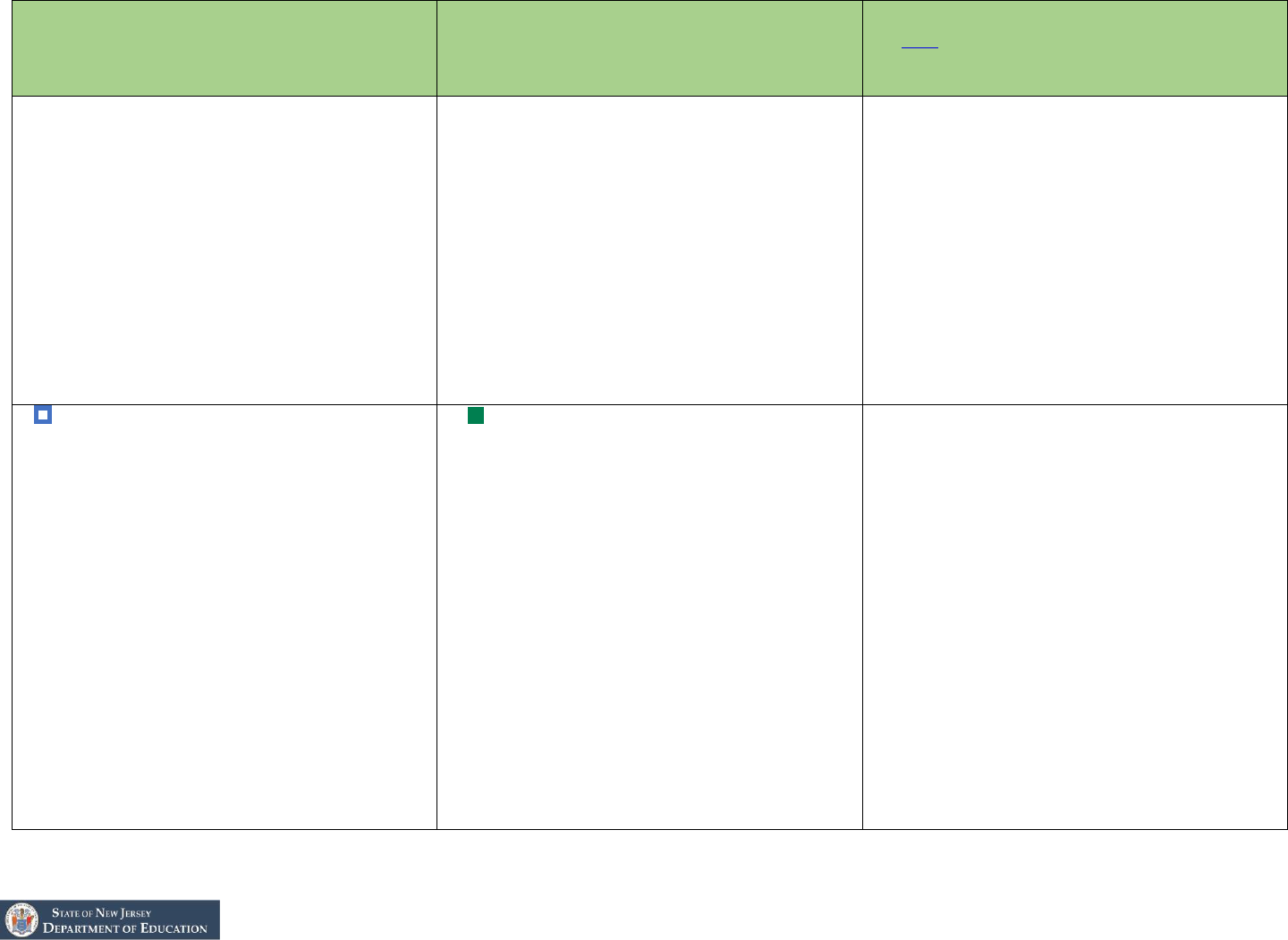
Grade 2: New Jersey Student Learning Standards for Mathematics - Prerequisite Standards and Learning Objectives
20
Updated February 2021
Standard and Student Learning
Objectives
Previous Grade(s) Standards and Student
Learning Objectives
Instructional Considerations
SAP recommendation to preserve or reduce
time in 20-21 as compared to a typical year
▪ add a two-digit number and a one-digit
number within 100 using concrete
models (e.g., base ten) or drawings
▪ add a two-digit number and a one-digit
number within 100 using strategies based
on place value or properties of operations
▪ add a two-digit number and a multiple of
10, within 100, using concrete models
(e.g., base ten blocks) or drawings
▪ add a two-digit number and a multiple of
10, within 100, using strategies based on
place value or properties of operations
2.MD.D.9 Generate measurement data by
measuring lengths of several objects to the
nearest whole unit, or by making repeated
measurements of the same object. Show the
measurements by making a line plot, where
the horizontal scale is marked off in whole-
number units.
We are learning to/that…
▪ generate measurement data by measuring
lengths, to the nearest whole unit, of
several objects
▪ generate measurement data by measuring
the same object multiple times
▪ record measurements in a line plot whose
horizontal scale is in whole number units
1.MD.A.1 Order three objects by length;
compare the lengths of two objects
indirectly by using a third object.
We have learned to/that…
▪ length is measured from one endpoint to
another
Eliminate lessons on generating
measurement data (2.MD.D.9) and creating
picture/bar graphs (2.MD.D.10).
Integrate data displays only as settings for
addition/subtraction word problems.
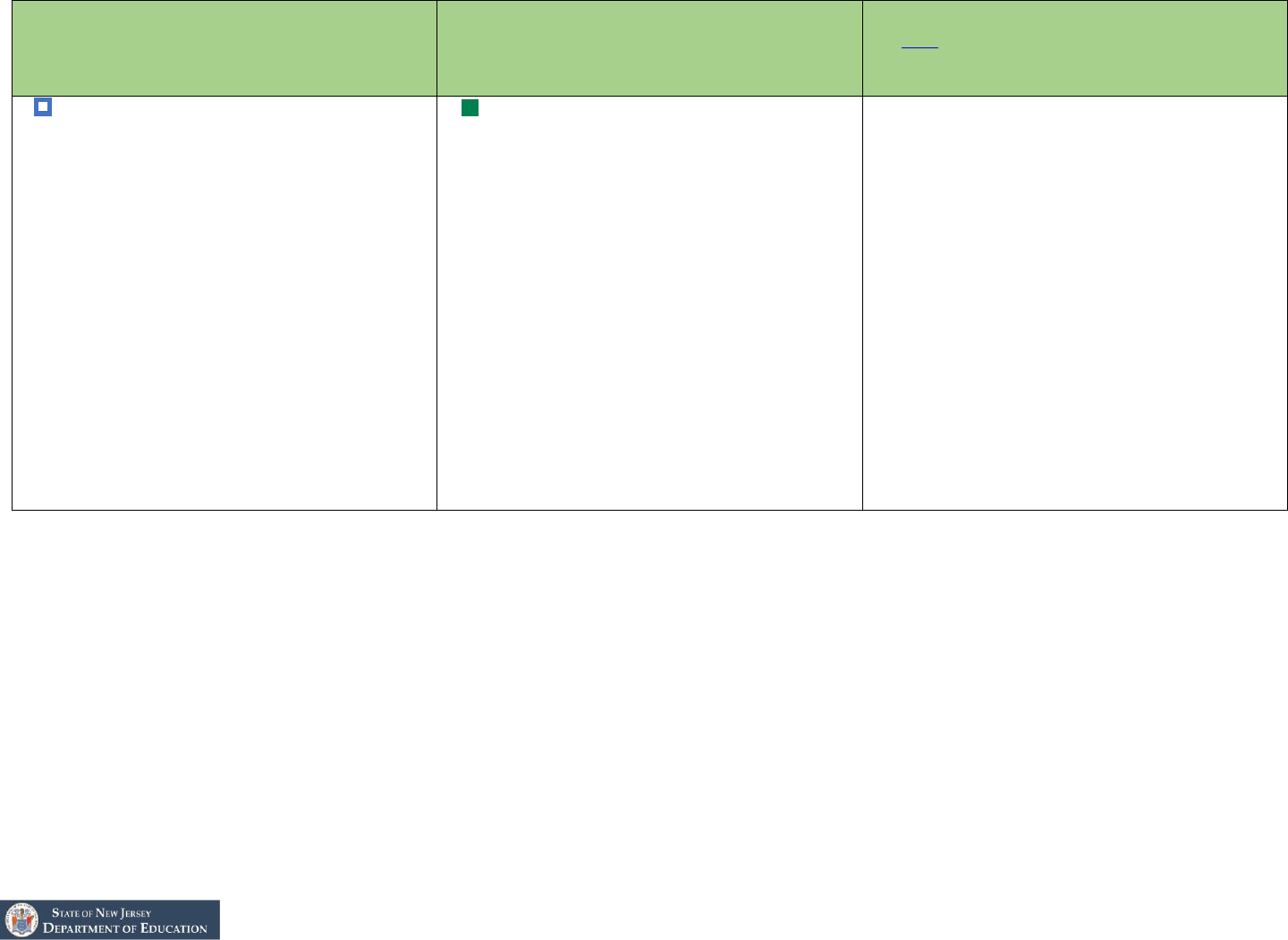
Grade 2: New Jersey Student Learning Standards for Mathematics - Prerequisite Standards and Learning Objectives
21
Updated February 2021
Standard and Student Learning
Objectives
Previous Grade(s) Standards and Student
Learning Objectives
Instructional Considerations
SAP recommendation to preserve or reduce
time in 20-21 as compared to a typical year
2.MD.D.10 Draw a picture graph and a
bar graph (with single-unit scale) to represent
a data set with up to four categories. Solve
simple put together, take-apart, and compare
problems using information presented in a
bar graph.
We are learning to/that…
▪ draw a picture graph to represent a data
set with up to four categories
▪ draw a bar graph to represent a data set
with up to four categories
▪ use information from a bar graph to solve
simple put together, take-apart, and
compare problems
1.MD.C.4 Organize, represent, and
interpret data with up to three categories; ask
and answer questions about the total number
of data points, how many in each category,
and how many more or less are in one
category than in another.
We have learned to/that…
▪ organize and represent data with up to
three categories
▪ interpret data with up to three categories
by stating observations about the data
▪ ask and answer questions about the total
number of data points, the number in
each category, and how many more or
less are in one category than in another
Eliminate lessons on generating
measurement data (2.MD.D.9) and creating
picture/bar graphs (2.MD.D.10).
Integrate data displays only as settings for
addition/subtraction word problems.
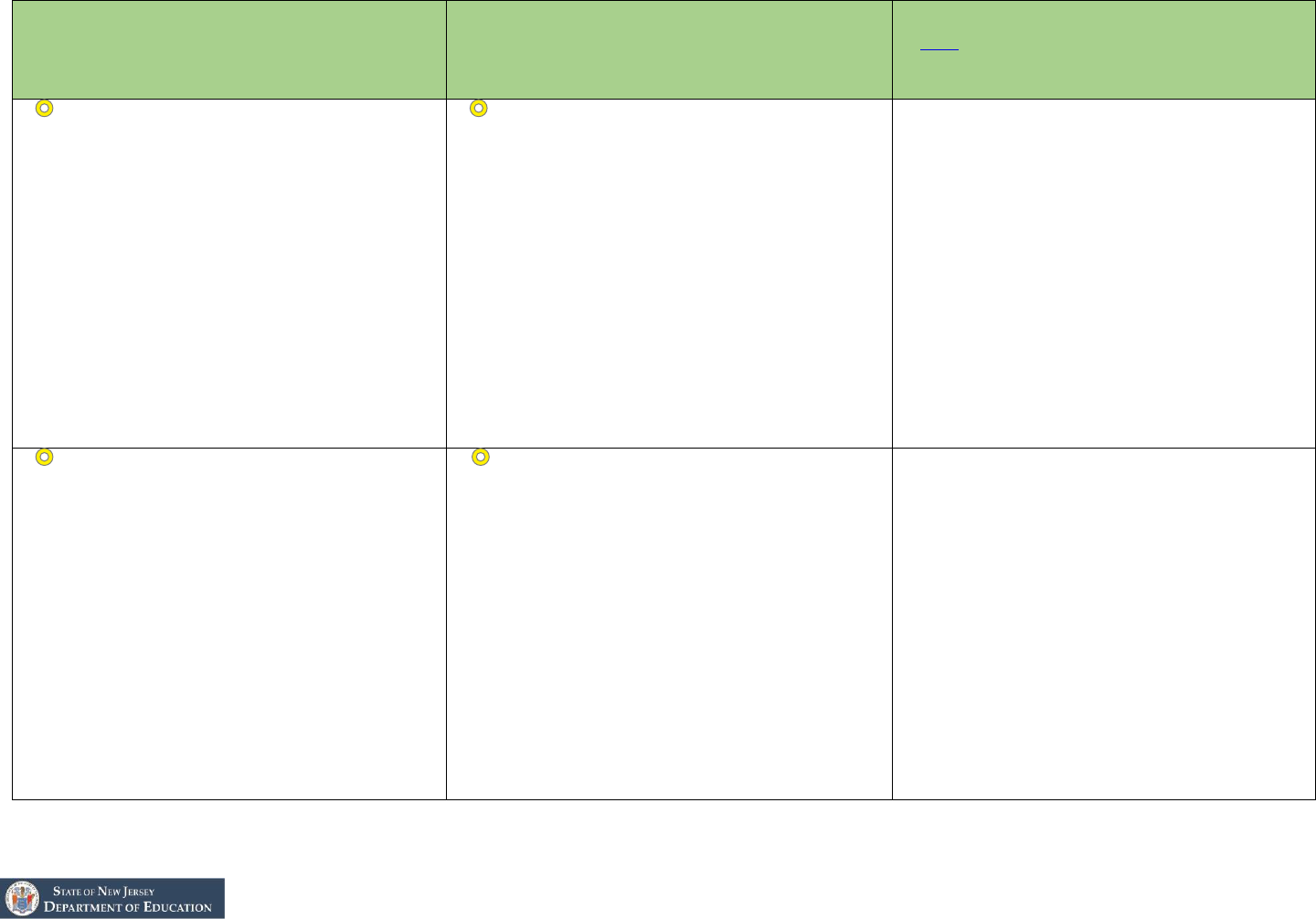
Grade 2: New Jersey Student Learning Standards for Mathematics - Prerequisite Standards and Learning Objectives
22
Updated February 2021
Domain: Geometry
Standard and Student Learning
Objectives
Previous Grade(s) Standards and Student
Learning Objectives
Instructional Considerations
SAP recommendation to preserve or reduce
time in 20-21 as compared to a typical year
2.G.A.1 Recognize and draw shapes
having specified attributes, such as a given
number of angles or a given number of equal
faces. Identify triangles, quadrilaterals,
pentagons, hexagons, and cubes.
We are learning to/that…
▪ recognize and draw shapes based on
their attributes, such as a given number
of angles or a given number of equal
faces
▪ identify cubes, triangles, quadrilaterals,
pentagons, and hexagons
1.G.A.1 Distinguish between defining
attributes (e.g., triangles are closed and three-
sided) versus non-defining attributes (e.g.,
color, orientation, overall size); build and
draw shapes to possess defining attributes.
We have learned to/that…
▪ distinguish between defining and non-
defining attributes
▪ build and draw shapes that have particular
defining attributes
Combine lessons to address key concepts
on reasoning with shapes and their
attributes to reduce the amount of time
spent on this cluster.
Limit the amount of required student
practice.
2.G.A.2 Partition a rectangle into rows and
columns of same-size squares and count to
find the total number of them.
We are learning to/that…
▪ partition a rectangle into rows and
columns of same-size squares and count
to find the total number of same size
squares
1.G.A.3 Partition circles and rectangles into
two and four equal shares, describe the shares
using the words halves, fourths, and quarters,
and use the phrases half of, fourth of, and
quarter of. Describe the whole as two of, or
four of the shares. Understand for these
examples that decomposing into more equal
shares creates smaller shares
We have learned to/that…
▪ partition means to split a shape into
smaller parts, also called shares
▪ decomposing shapes into more equal
shares creates smaller shares
Combine lessons to address key concepts
on reasoning with shapes and their
attributes in order to reduce the amount of
time spent on this cluster.
Limit the amount of required student
practice.
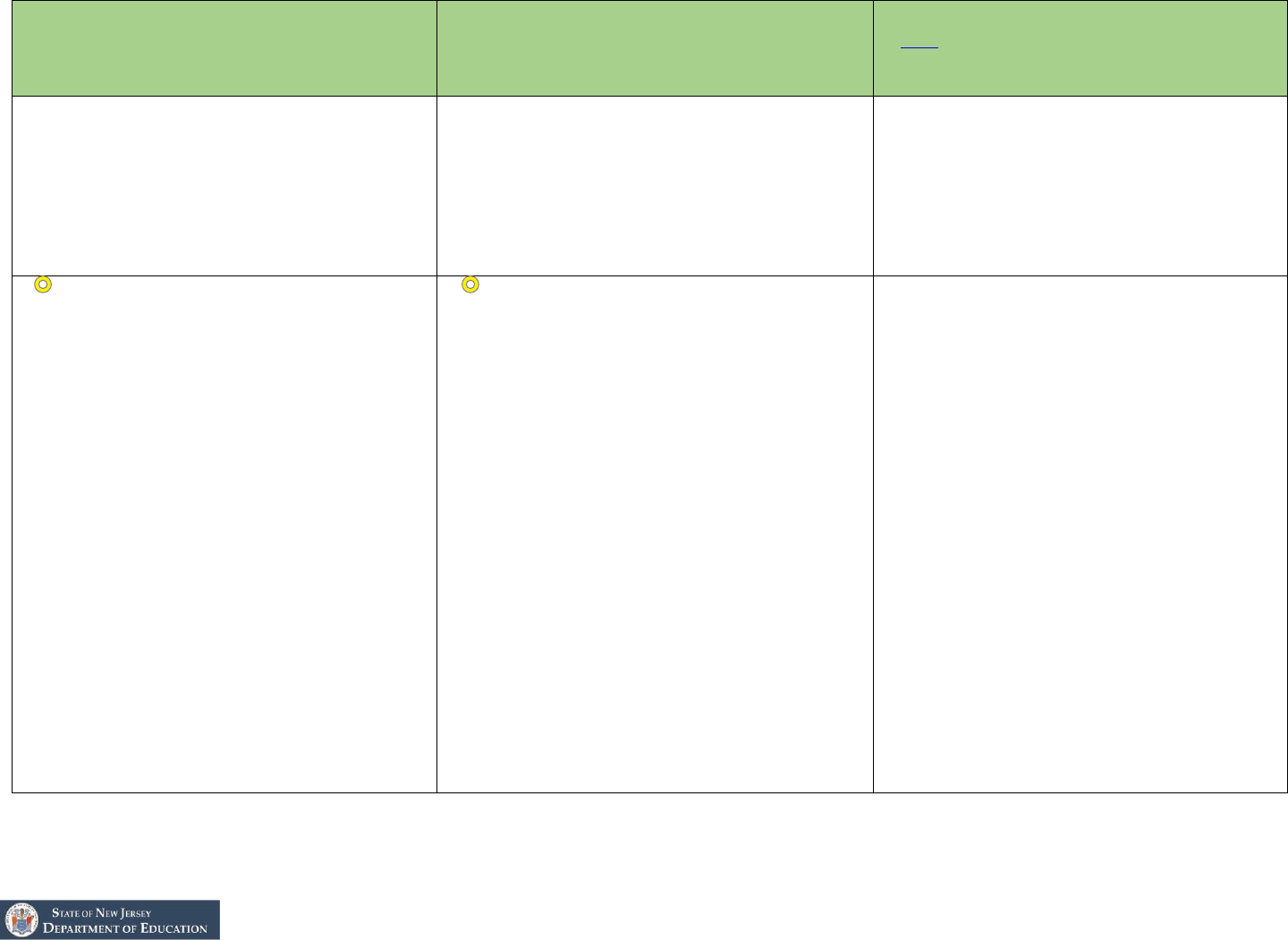
Grade 2: New Jersey Student Learning Standards for Mathematics - Prerequisite Standards and Learning Objectives
23
Updated February 2021
Standard and Student Learning
Objectives
Previous Grade(s) Standards and Student
Learning Objectives
Instructional Considerations
SAP recommendation to preserve or reduce
time in 20-21 as compared to a typical year
▪ partition circles and rectangles into two
equal shares and describe each share using
the word “halves” or the phrase “half of”
▪ partition circles and rectangles into four
equal shares and describe each share using
the word “fourths” or the phrase “fourth
of”
2.G.A.3 Partition circles and rectangles
into two, three, or four equal shares, describe
the shares using the words halves, thirds, half
of, a
third
of, etc., and describe the whole as
two halves, three thirds, four fourths.
Recognize that equal shares of identical
wholes need not have the same shape.
We are learning to/that…
▪ partition circles and rectangles into two,
three, or four equal shares
▪ describe the shares using the words
halves, thirds, fourths, half of, a third of,
or fourth of
▪ describe the whole as two halves, three
thirds, four fourths
▪ recognize that equal shares of identical
wholes need not have the same shape
1.G.A.3 Partition circles and rectangles into
two and four equal shares, describe the shares
using the words halves, fourths, and quarters,
and use the phrases half of, fourth of, and
quarter of. Describe the whole as two of, or
four of the shares. Understand for these
examples that decomposing into more equal
shares creates smaller shares
We have learned to/that…
▪ partition means to split a shape into
smaller parts, also called shares
▪ partition circles and rectangles into two
equal shares and describe each share using
the word “halves” or the phrase “half of”
▪ partition circles and rectangles into four
equal shares and describe each share using
the word “fourths” or the phrase “fourth
of”
▪ decomposing shapes into more equal
shares creates smaller shares
Combine lessons to address key concepts
on reasoning with shapes and their
attributes in order to reduce the amount of
time spent on this cluster.
Limit the amount of required student
practice.
